










































































































































Tunisia is the largest olive oil producer outside the EU. With presidential elections this year amid a troubled economy, what are the prospects for the oils and fats sector and the country?












































































































































Tunisia is the largest olive oil producer outside the EU. With presidential elections this year amid a troubled economy, what are the prospects for the oils and fats sector and the country?
Bioplastics


34 Growth in high oleics
With global demand for peanuts forecast to reach 54M tonnes by 2026, new high oleic varieties are being developed, including by leading producer India
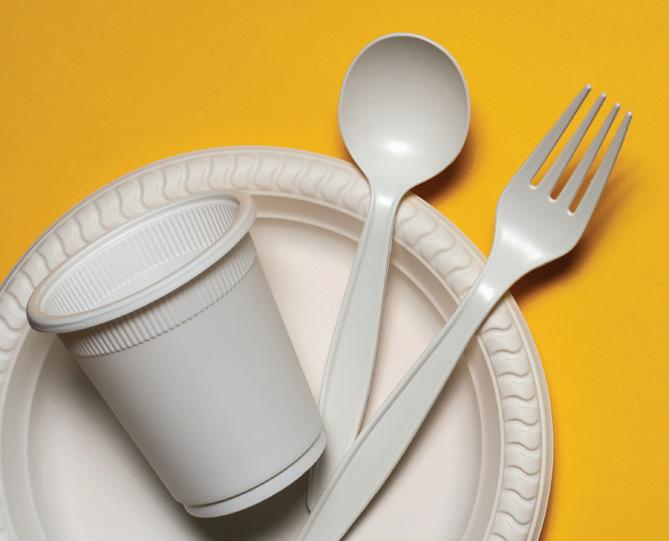
38 Set for growth
While bioplastics still only represent some 0.5% of plastics produced globally, their production is growing, presenting an opportunity for the oils and fats sector Deep Frying

41 Regulatory update
A range of regulations govern deep frying to safeguard consumer health, covering the quality of fresh and used cooking oil, as well as additives, allergens, trans fatty acids, genetically modified oils and compounds such as acrylamide, 3-MCPDEs and GEs


Comment
2 The future of HVO, SAF News
4 COFCO delivers its first deforestation-free soya
Biofuel News
10 Tighter checks urged on EU imports of biofuels
Renewable News
14 Unilever to reduce palm oil content in Indian soap brands
Transport News
16 Bunge, Zen-Noh buy stake in Brazil terminal
Biotech News
18 ADM expands with non-GM line
Diary of Events
19 International events listing OFI International 2024
20 Full event and conference programmes
International Market Review
26 Oil output growth leans on soya
Statistics
44 World statistical data
VOL 40 NO 6
JULY/AUG 2024
EDITORIAL:
Editor: Serena Lim serenalim@quartzltd.com +44 (0)1737 855066
Assistant Editor: Gill Langham gilllangham@quartzltd.com +44 (0)1737 855157
SALES:
Sales Manager: Mark Winthrop-Wallace markww@quartzltd.com +44 (0)1737 855114
Sales Consultant: Anita Revis anitarevis@quartzltd.com +44 (0)1737 855068
PRODUCTION:
Production Editor: Carol Baird carolbaird@quartzltd.com
CORPORATE:
Managing Director: Tony Crinion tonycrinion@quartzltd.com +44 (0)1737 855164
SUBSCRIPTIONS: Jack Homewood subscriptions@quartzltd.com +44 (0)1737 855028
Subscriptions, Quartz House, 20 Clarendon Road, Redhill, Surrey RH1 1QX, UK

© 2024, Quartz Business Media ISSN 0267-8853
WWW.OFIMAGAZINE.COM

A member of FOSFA
Oils & Fats International (USPS No: 020-747) is published eight times/year by Quartz Business Media Ltd and distributed in the USA by DSW, 75 Aberdeen Road, Emigsville PA 17318-0437. Periodicals postage paid at Emigsville, PA.
POSTMASTER: Send address changes to Oils & Fats c/o PO Box 437, Emigsville, PA 17318-0437
Published by Quartz Business Media Ltd
Quartz House, 20 Clarendon Road, Redhill, Surrey RH1 1QX, UK oilsandfats@quartzltd.com +44 (0)1737 855000
Printed
by
Pensord Press, Merthyr Tydfil, Wales

These days, it seems that not a day goes by without the announcement of a new renewable diesel (HVO) or sustainable aviation fuel (SAF) project.
According to the International Air Transport Association, total renewable fuel production capacity could reach 51M tonnes by 2030, while SAF volumes will grow six-fold from 0.25M tonnes in 2022 to 1.5M tonnes this year. This is still just a drop in the ocean in proportion to our fossil fuel needs – 1.5M tonnes of SAF is just 0.5% of aviation’s total fuel consumption, while to meet all of 2022 US diesel fuel consumption in the transportation sector would require more than 160M tonnes of feedstock, 10 times the US production of vegetable oils that year, according to the US Energy Information Administration. Yet even the relatively small amount of HVO and SAF currently being produced is already having a significant impact across major sectors of the oils and fats market.
Increased US renewable diesel production has led to dramatic rises in American imports of vegetable oils and animal fats, according to a 14 June US Department of Agriculture (USDA) Foreign Agricultural Service (FAS) report. US import values of all animal fats and vegetable oils more than doubled from 2020 to 2023, while the US share of Canadian canola oil exports has risen from some 50-60% in recent years to 91% in 2023.
With so much US soyabean oil going into the renewable diesel sector, domestic soya crushing is expected to reach record levels for the fourth consecutive year, with the country becoming a net soyabean oil importer for the first time in 2023. As a by-product of soyabean oil production, soya meal supplies and exports have also surged but “US crush and renewable diesel growth could be limited by the ability to find an outlet for surplus soyabean meal,” the USDA report says.
Waste oils and fats have benefitted from the boom in HVO/SAF production as they have a lower carbon score than vegetable oils. US imports of Brazilian tallow soared 377% in the first four months of this year (see p10) and Global Data has said oleochemical use of tallow is falling due to greater competition and higher prices.
The UCO market is even more controversial with both the USA and Europe concerned about fraudulent, adulterated UCO imports from countries like China and Malaysia.
With the fierce competition and concerns about feedstocks, what is the real picture of future HVO and SAF volumes? A lot will depend on government policies and mandates.
Much of the recent renewable diesel growth has come from the conversion of crude oil refineries, according to Jeremy Martin, director of fuels policy at the Union of Concerned Scientists. Their capacities may be overstated as these may be based on the size of existing infrastructure, while the decision to convert forestalls the need to begin the costly process of decommissioning an old refinery. “The realistic potential for biofuel conversions is quite small because of the limited availability of suitable feedstocks,” Martin writes.
It is worth noting that global oil majors bp and Shell have both just announced that they are actually scaling back their SAF and HVO development plans (see p10).
The need to decarbonise transport and tackle global emissions is urgent and the most achievable way to do this currently is to use HVO and SAF made from virgin and waste oils and fats. However, there is no long term future in using oils and fats for fuels on an unsustainable scale and the world needs to develop other low carbon technologies to achieve our climate goals.
Issues like the impact of HVO and SAF on the global vegetable oil market and prices will all be addressed by leading industry experts at OFI International 2024 in Rotterdam on 9-11 September. Our full conference programmes are on p20-25 and we hope to see as many of you there as possible.
Serena Lim, serenalim@quartzltd.com
POLAND: Global agribusiness giant ADM and German chemical firm Bayer have extended their regenerative agriculture partnership following the completion of a year-long rapeseed study in Poland, World Grain wrote on 13 June.
As part of the study into the impact of regenerative agriculture in curbing carbon emissions, increasing biodiversity and improving soil health, the companies worked with rapeseed farmers covering approximately 9,000ha in Poland.
Assessments showed that carbon emissions from farmland relying on at least one regenerative agricultural practice were 15% lower than those of conventional farms, World Grain wrote. Emission reduction could be up to 40% for farmers comprehensively adopting regenerative agriculture practices.
As part of the next stage of the partnership, the programme would be expanded into a broader range of crops such as corn, wheat and barley, and geographically across Eastern Europe, the report said.
Farmers would be provided with financial and technical support to introduce qualifying regenerative agriculture practices, including minimum tillage, cover crops, companion crops, nutrient management, use of organic matter/manure and crop rotation.
ADM would compensate participating farmers for each qualifying hectare measured and verified using Bayer’s digital capabilities in collaboration with Trinity Agtech’s Sandy platform. In addition to financial support, participating farmers would receive agronomic guidance from specialised professionals.

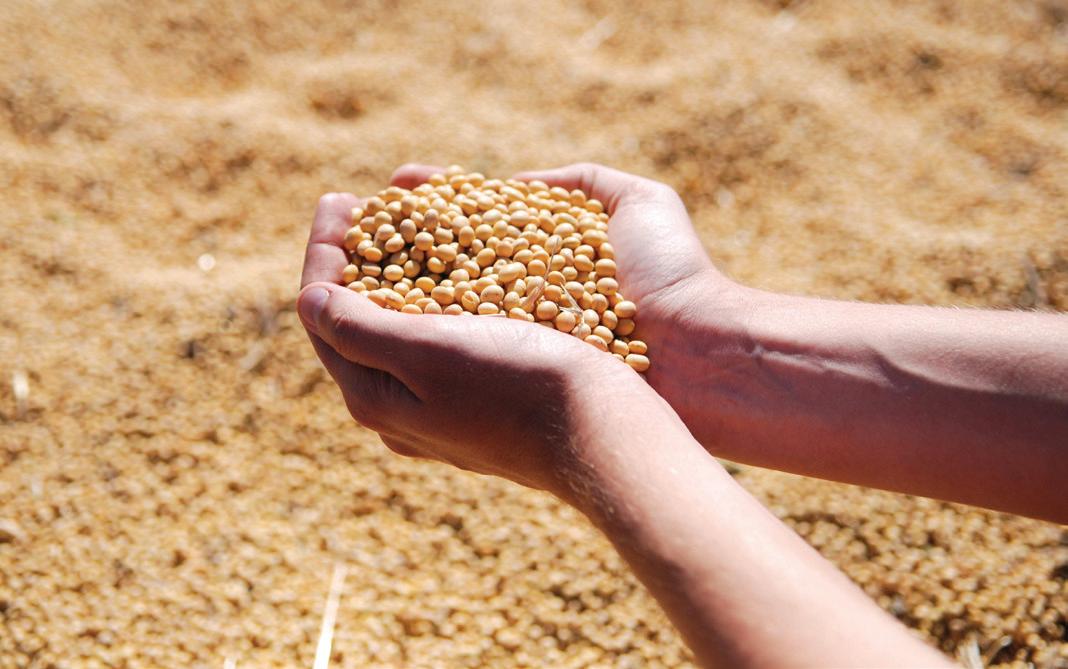
China’s largest food processor and manufacturer COFCO International has delivered its first shipment of deforestationand conversion-free (DCF) Brazilian soyabeans, World Grain reported on 4 June.
The 50,000 tonne shipment delivered on 31 May to Tianjin, China, was part of an agreement with the Mengniu Group.
The deal was the first in China to include a DCF clause and was initiated through the World Economic Forum's and Tropical Forest Alliance’s Taskforce on
Value Chains for
World Grain wrote.
As a major exporter of Brazilian soyabeans, COFCO International said it was taking steps to improve traceability, risk management and supplier performance. It had set a target of achieving a deforestation-free soyabean supply chain by 2025 and to reduce emissions from land use change.
As part of these targets, the company was working with industry initiatives such as the Taskforce on Green Value
Chains for China, the Soft Commodities Forum and the Agricultural Sector Roadmap to 1.5°C, the report said.
To ensure the soyabeans reaching Mengniu Group were deforestation- and conversion-free, COFCO used a mass balance model, a volume-tracking system that enables a specific quantity of soyabeans to be sold as certified.
As the world’s largest buyer and importer of soyabeans from Brazil, China was key in the transition towards DCF soyabean production and trade, COFCO said.
In preparation for the EU Deforestation Regulation (EUDR), the company also had plans to source, process and ship segregated soyabeans, where certified volumes are kept physically separate from source through to processing, storage and distribution. COFCO loaded its first fully traceable and segregated shipment of soyabean meal out of Argentina for delivery to Ireland in May.
The European Bank for Reconstruction and Development (EBRD) is set to loan €60M (US$64.44M) to Ukrainian company Lan-Oil to finance the construction of a new biofuels project in the country.
Backed by a financial guarantee from the EBRD’s first investment in a biofuels project in the country since Russia’s invasion in 2022 was part of efforts to counteract Russian strikes on Ukrainian power infrastructure, the EBRD said on 12 June.
Signed at the Ukraine Recovery Conference (URC) in Berlin on the day of the report, the project would contribute to Ukraine’s energy security and the decarbonisation of the sector by building a domestic source of renewable fuel supply – bioethanol – with 70% lower greenhouse gas emissions than traditional fuel, the bank said.
The sponsor is JSC Concern Galnaftogaz and
OKKO Group, a leading Ukrainian distributor of transportation fuels.
As of December 2023, JSC Concern Galnaftogaz owned and operated 396 OKKO-branded filling stations.
The biofuel produced was expected to be compliant with the EU Renewable Energy Directive (RED III), the EBRD said.
Energy security is one of the EBRD’s five investment priorities for Ukraine, along with support for vital infrastructure, food security, trade and the private sector.
Since the start of the war, the EBRD said it had made over €4.2bn (US$4.5bn) available to Ukraine and its shareholders and had recently agreed to provide a €4bn (US$4.29bn) paid-in capital increase to enable the bank to continue investing at current levels in wartime, with the potential for more investments when reconstruction started.











Maximize your Hemp CBD Oil market opportunity in an environmentally responsible way with Crown.
From hemp preparation to CBD extraction— full spectrum and broad spectrum oils—Crown gets you up and running with optimized ef ciencies. As a leader in oilseed extraction for 70 years and botanical extraction for 30 years, Crown equips you to achieve input capacities ranging from 5 to 50+ MTPD with an environmentally responsible >99% solvent recovery rate and only 2 plant operators required. Crown’s Continuous Extraction System for Hemp CBD Oil delivers exceptional performance and full scalability to meet the speed and capacity your customers demand, now and in the future.





Hit your launch date and growth targets with Crown’s Continuous Extraction System for Hemp CBD Oil. Contact CPM and Crown today 1-651-894-6029 or visit our website at www.crowniron.com

The Turkish government has partially lifted its ban on olive oil exports introduced in August to lower domestic prices, following intense lobbying from the sector, Olive Oil Times wrote on 12 June.
Turkish producers would now be able to export 50,000 tonnes of bulk olive oil until 1 November. However, with forecasts of a bumper harvest in 2024/25, the sector continued to call for the ban to be lifted completely, the report said.
Istanbul Commodity Exchange chair Ali
BRAZIL: Recent floods in southern Brazil and lower yields across several states have reduced the country’s soyabean production expectations to 150M tonnes in the 2023/24 marketing year, according to a US Department of Agriculture (USDA) Foreign Agricultural Service (FAS) report.
The reduction was mainly due to May’s unprecedented floods in the southernmost state of Rio Grande do Sul in May and lower yields in Mato Grosso, Mato Grosso do Sul, Paraná and São Paulo, the 1 July Global Agricultural Information Network (GAIN) report said.
Revised national yields totalled 3,275kg/ha, 10% lower than record productivity in 2022/23.
The FAS reduced its export estimates for 2023/24 to 94M tonnes, while increasing crushing volumes to 55.1M tonnes to meet domestic demand.
For 2024/25, the FAS increased its soyabean area forecast to 46.3M ha.
Soyabean production in 2024/25 was forecast at 160M tonnes, and exports at 99M tonnes due to sustained international demand, higher harvested volumes, a favourable exchange rate and higher competitiveness.
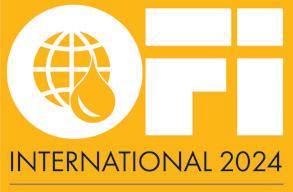
Kopuz was quoted as saying that Turkey had twice the amount of olive oil it needed to supply the domestic market.
The Aegean Olive and Olive Oil Exporters’ Association (EZZIB) has forecast Turkish production to reach 400,000 tonnes in 2024/25, slightly below the record high yield in the 2022/23 crop year but significantly above the previous year’s harvest.
Combined with existing olive oil stocks of 200,000 tonnes and production from Afrin, a region in northern Syria occupied
by Turkey, EZZIB chairman Mehmet Emre Uygun estimated that the country could have 650,000 tonnes of olive oil available by the end of the harvest.
“If bans are left behind, we believe we will reach the export target of US$1bn (€932M) for the first time in our history in the 2024/25 crop year,” Uygun said.
Turkey ranks among the top five olive oil producers in the world, behind Spain, which accounts for around half of the 3M tonnes/year of olive oil produced globally.

Global agribusiness giant Bunge Global and feed ingredient firm Bangkok Produce (BKP) have jointly tested a soyabean tracing platform using blockchain technology.
The test involved three shipments from Brazil totalling 185,000 tonnes of deforestation-free soyabean meal for delivery to Thailand, Bunge said on 11 June. Through the shipments, Thailand food conglomerate Charoen Pokphand
Foods (CPF) said it would be able to trace the soyabeans from farm origin, processing and transportation to delivery at destination. CPF is the parent company of BKP.
Three additional ships were due to deliver 180,000 tonnes of soyabean meal by July.
The two companies have been working in collaboration since October 2023, when they announced a partnership to develop a blockchain traceability solution aimed at building a sustainable and digitally integrated supply chain. The agreement involves oilseeds and their byproducts sourced by Bunge in Brazil for shipment to several countries in Asia, where BKP and CPF produce and sell feed and food.
In addition to compliance with a range of socio-environmental criteria, their blockchain platform offered customers access to information including the carbon footprint of volumes sold and details of regenerative agricultural practices adopted by farms, Bunge said, adding that since the end of 2022, its supplier monitoring system had covered more than 16,000 farms on around 20M ha of land in South America.
The US state of Michigan’s Cannabis Regulatory Agency (CRA) is set to ban medium chain triglyceride (MCT) oil in vape pens.
As part of its Sampling and Testing Technical Guidance for Marijuana Products, cannabis oil in vapes would have to be tested for MCTs from 1 October, the CRA said on 27 June.
Commonly derived from coconut or palm oil, MCT oil is mainly used in oral supplements and food products. However, when aerosolised and inhaled, MCT oil could be harmful to respiratory health, the CRA said.
“From a public health and safety standpoint, the potential for adverse effects with MCT oil underscores the importance of safety guidelines
for product development,” CRA executive director Brian Hanna was quoted as saying.
“Michigan’s licensed marijuana businesses must prioritise respiratory safety when formulating or using inhalable products, opting for ingredients that have been thoroughly evaluated for their compatibility with lung health.”
Welcoming the CRA’s move, the Michigan branch of the National Organization for the Reform of Marijuana Laws (MiNORML) said emerging evidence "suggests that inhaling MCT oil can pose serious respiratory risks, and it’s imperative that we take proactive measures to prevent potential harm,” MiNORML executive director Anqunette Sarfoh was quoted as saying.
China's first food security law aimed at achieving "absolute self-sufficiency" in staple grains – comprising wheat, rice, corn, soyabeans and coarse grains – came into force on 1 June, Reuters reported on 3 June.
Passed just six months after its first reading, the rush to adopt the law reflected China's urgency to resolve issues that had curbed production, such as a lack of arable land and water resources, labour shortages and a lack of agriculture technology, the report said. The law would hold central
Bulgaria's rapeseed imports nearly doubled in the 2023/24 marketing year while its crush was 134% higher compared with 2022/23, according to the US Department of Agriculture (USDA) 25 June Foreign Agricultural Service (FAS) Bulgaria: Oilseeds and Products Market Update report.
Rapeseed imports increased by 90% to reach 182,000 tonnes in 2023/24 against the previous year's 96,000 tonnes, with most of the imports coming from Ukraine and Moldova.
Crushing totalled 197,000 tonnes in 2023/24, 134% higher than in the previous year.
“As a result, trade in processed products has accelerated. Rapeseed oil exports in the first three quarters of 2023/24 reached 20,000 tonnes, a growth of 82% compared to the same period in 2022/23.”
Exports of rapeseed meal surged by 430% from 19,000 tonnes in 2022/23 to 103,000 tonnes, the FAS said. The main export markets for rapeseed oil were in the EU –Spain and the Netherlands – Israel and Morocco were the main destinations for rapeseed meal.
Bulgaria’s rapeseed production was forecast 4% down for 2024/25 to about 200,000 tonnes.
Sunflowerseed production declined by 16% in 2023/24 to 1.78M tonnes but Bulgaria increased its sunflowerseed crushing by reducing exports, allowing it to keep its position as the top EU exporter of sunflower oil.
and provincial governments accountable for incorporating food security into their economic and development plans, without giving details on how it would be implemented.
The law included protection of farmland from being converted to other uses, protecting germplasm resources and preventing wastage.
As the world’s leading agricultural importer with the second largest population at 1.4bn people, China had made reducing reliance on overseas suppliers a priority in
recent years, World Grain wrote on 3 June. China produced one-fourth of the world’s grain and fed one-fifth of the world’s population with less than 10% of the world’s arable land, the report said.
Analysts said the law was worded vaguely and might not have a significant impact on how China boosted food production.
"Food security is already among the top national priorities and can't go any higher," Even Pay, agriculture analyst at Beijing-based consultancy Trivium China, was quoted as saying.
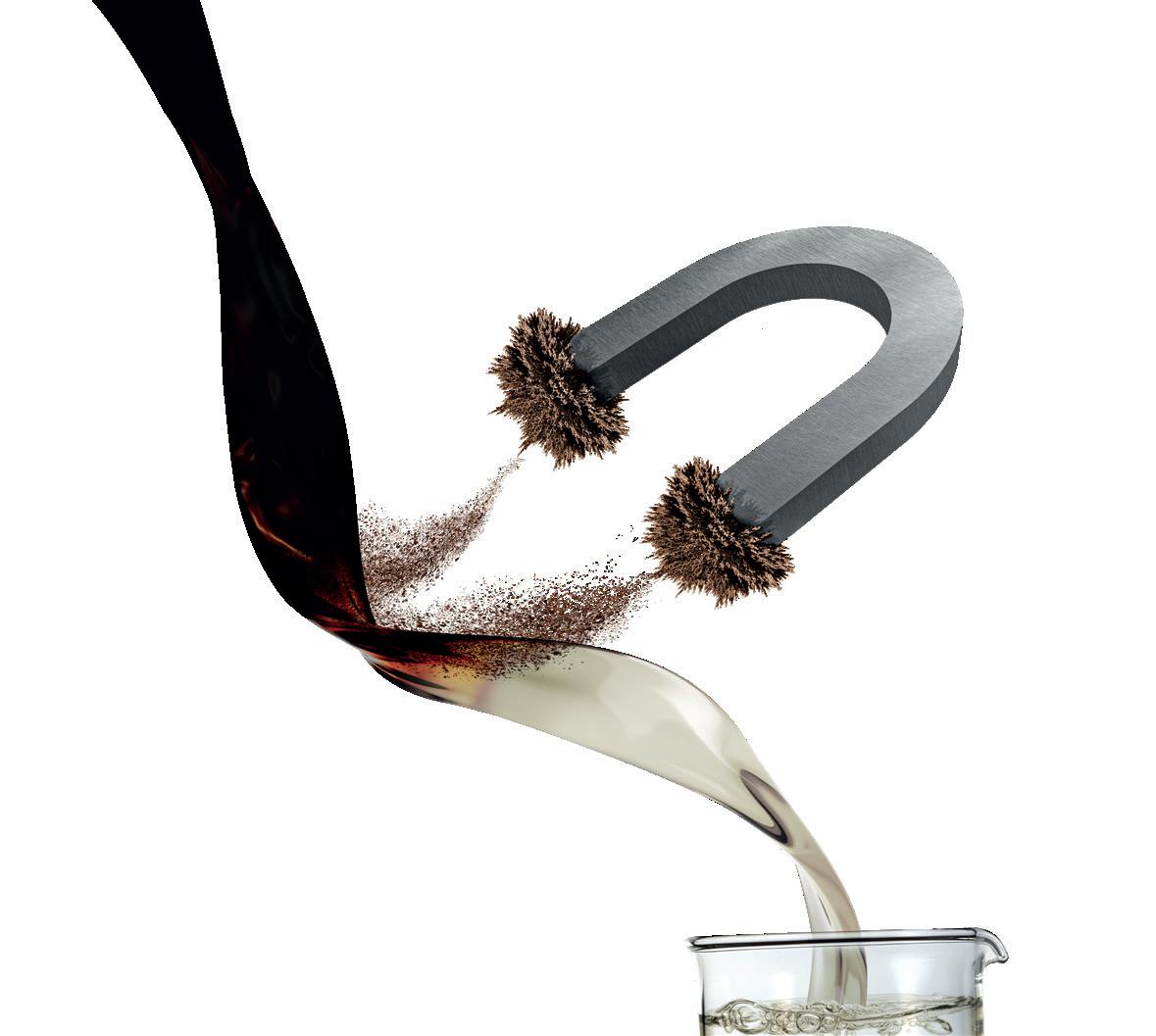

WORLD: The US Department of Agriculture (USDA) Foreign Agricultural Service (FAS) has lowered its 2024/ 25 oilseeds production forecast by more than 1M tonnes to 686M tonnes, due to a reduced rapeseed outlook in Australia.
In its June Oilseeds: World Markets and Trade report, the FAS also reduced its 2024/25 estimate for global oilseeds trade due to lower Australian rapeseed exports.
Oilseed ending stocks were forecast down by almost 1M tonnes due to reduced stocks of Brazilian soyabeans and global rapeseed.
The FAS also lowered its estimate for global crushing due to reduced rapeseed consumption.
Despite an increase in Ukrainian rapeseed, the global oilseeds production forecast for 2023/24 was lowered due to a reduction in Brazilian soyabeans and Indian peanuts.
“Global oilseeds trade is up slightly on higher Ukraine rapeseed exports exceeding lower Canada rapeseed exports,” the report said.
World ending stocks were down almost 600,000 tonnes due to a decline in Brazil soyabean stocks, while oilseed crushing was reduced due to lower Indian peanut crushing.
Ultra-processed food is responsible for about 391,000 deaths a year in Europe, according to new World Health Organization (WHO) report, 'Commercial Determinants of Non-communicable Diseases in the WHO European Region.'
When taken alongside alcohol, fossil fuels and tobacco, the four industries were responsible for more than 2.7M deaths a year – about one quarter of all fatalities – in Europe, and at least one third of deaths [19M] and 41% of non-communicable disease deaths globally, WHO said on 12 June.
Although there was no formal definition of ultra-processed food, the widely used Nova classification – a system used worldwide in nutrition and public health research, policy and guidance –described ultra-processed foods as “formulations
made mostly or entirely from substances derived from foods and additives” with negligible use of raw or natural foods in the preparation, Olive Oil Times wrote on 25 June.
The report found that diets high in sodium were responsible for 252,187 deaths/year –2.27% of the total – followed by diets high in processed meat (117,290 deaths/year, 1.07%), diets high in sugar-sweetened beverages (15,606 deaths/year, 0.14%) and diets high in trans fatty acids (6,056 deaths/year, 0.05%).
The WHO report called on governments to adopt stronger regulations and legislation to curb the marketing of health-harming products; increase the transparency of lobbying and conflicts of interest in industry-funded health research; and raise taxes on multinationals.

Worldwide sunflowerseed production in 2024/25 is forecast at 57.21M tonnes compared to 57.4M tonnes the previous year due to
smaller harvests in Argentina, China and Russia, according to the latest forecast by the International Grains Council (IGC) reported by Germany’s
Union for the Promotion of Plants and Protein on 31 May.
Above average yields would only partially compensate for a reduced planted area.
Russia was forecast to produce 17.2M tonnes, 1.1% lower than in 2023/24, but was still set to remain the world’s leading supplier.
The EU was projected to produce 10.7M tonnes this season, 500,000 tonnes more than in the previous year.
Ukraine was expected to produce 6.2M tonnes.
At 700,000 tonnes, US production would be the smallest in 48 years.
Trade associations have raised concerns about the EU Deforestation Regulation (EUDR) information system with European Commission President Ursula von der Leyen in a letter to her on 17 May.
"The impact an inoperable information system will have leads us to bring this to your attention,” the letter said, which urged:
• Opening up the information system for all users as soon as possible and at the start of November at the very latest.
• A second round of testing with the business community.

• Making the Application Programming Interface (API) specifications ready for businesses to prepare.
• Lifting the 25MB limitation or substantially increasing the size for uploading files as part of the due diligence system.
• Accepting other data formats in addition to the GeoJson standard.
Signatories of the letter included EU trade association for cereals, rice, feedstuffs, oilseeds, olive oil, oils and fats (COCERAL) and EU vegetable oil and protein meal industry association (FEDIOL).
Under the EUDR, which takes effect on 30 December, any operator or trade which places soyabeans, palm oil, coffee, cattle, cocoa, wood and rubber or their derivatives on the EU market must prove that the products do not originate from land deforested since 2020 and provide geographical information on the land where these commodities have been grown.
























USA/BRAZIL: The US government is opening the door to Brazilian used cooking oil (UCO) by accepting the International Health Certificate on Vegetable Products (CSIV), Bloomberg reported on 20 June.
Based on audits of storage facilities’ and exporters’ self-regulation protocols, the Department of Inspection of Products of Plant Origin of Brazil’s Ministry of Agriculture and Livestock (Mapa) would certify the UCO’s traceability, identity and origin to comply with US regulations, the report said.
According to the US International Trade Commission, US imports of UCO more than tripled in 2023 compared to the previous year, with more than half shipped from China.
The increase in UCO imports from China had raised concerns that some shipments were allegedly fraudulent, Bloomberg wrote.
US trade groups and biofuel representatives have been calling for tighter regulation of imports, including improved methods of testing UCO purity, while a US soyabean trade association had also called for increased tariffs on Chinese UCO, the report said.
The governments of France, Germany and the Netherlands have called on the EU to adopt stricter checks on overseas suppliers of biofuel as the bloc investigates allegedly fraudulent imports from Asia, Reuters reported on 31 May.
The European biodiesel industry – worth some €31bn (US$33.6bn)/year – has reported a surge in Chinese biodiesel imports which it claims involve supplies produced with virgin oil despite being declared as made with recycled oils and fats. In a note submitted to a meeting of EU energy ministers on 30 May, France, Germany and the Netherlands said it was necessary to tighten checks on biofuel production sites “wherever they are located in the world”.
Certification of foreign biofuel as sustainable should be “rejected in case of refusal of access to the premises”, the note said.
Although no objections to the proposal had been raised at the meeting, no action had been taken, with the matter left with the European Commission (EC) to follow up, an EU diplomat was quoted as saying.
The EC is conducting several investigations into biofuel imports, including one on biodiesel from Indonesia allegedly circumventing EU duties and another on alleged dumping of lowpriced biodiesel from China. Some US producers had also reported an increase in shipments of recycled oil from China, Reuters wrote.

The International Air Transport Association (IATA) said on 3 June that its forecast for sustainable aviation fuel (SAF) production to triple in 2024 to 1.5M tonnes – accounting for 0.53% of aviation’s total fuel needs – is on track.
“SAF will provide about 65% of the mitigation needed for airlines to achieve net zero carbon emissions by 2050. The … expected
tripling of SAF production in 2024 from 2023 is encouraging, [but] we still have a long way to go,” IATA director general Willie Walsh said.
With some 140 renewable fuel projects capable of producing SAF scheduled to be in production by 2030, total renewable fuel production capacity could reach 51M tonnes by 2030, the date governments had set to achieve a 5% CO₂ emissions reduction for international aviation from SAF, IATA said. To achieve this, around 27% of all expected renewable fuel production capacity available in 2030 would need to be SAF. Currently, SAF accounted for just 3% of all renewable fuel production. With a typical three-to-five-year time lag from planning to production, investment announcements as late as 2027 could be in production by 2030, although not all announcements reached final investment decisions, IATA said.
US imports of Brazilian tallow for biofuel production surged by 377% in the first four months of this year compared to the previous year, Bloomberg reported on 13 June.
According to US government trade data, US tallow imports had increased four-fold since 2019 to a record 779,300 tonnes in 2023, with Brazil’s share of the shipments jumping from 23% last year to 40% in the first four months of this year.
US biofuel producers including Diamond Green Diesel and Marathon Petroleum had been sourcing cheaper raw materials

from overseas in a bid to boost margins, the report said. Renewable diesel made from waste fat or used cooking oil (UCO) had a lower carbon score than soyabean oil and was eligible for higher tax credits in California, where a high percentage of US green diesel was consumed, Bloomberg wrote.
With a new federal tax credit also due to be introduced next year, tallow and UCO would become more lucrative as feedstocks compared with US soyabean oil, affecting the profits and expansion plans of
leading soyabean producers such as Bunge and Archer Daniels Midland (ADM).
Tallow is abundant in Brazil, which slaughters more cows than any other country except China, according to the report.
Brazil rarely exported tallow until 2022, when Texas-based Darling Ingredients acquired Brazil’s largest independent rendering company FASA Group.
Since then, FASA had become a waste fat supplier to Diamond Green Diesel, a biofuel venture between Darling and Valero Energy Corp, Bloomberg wrote.
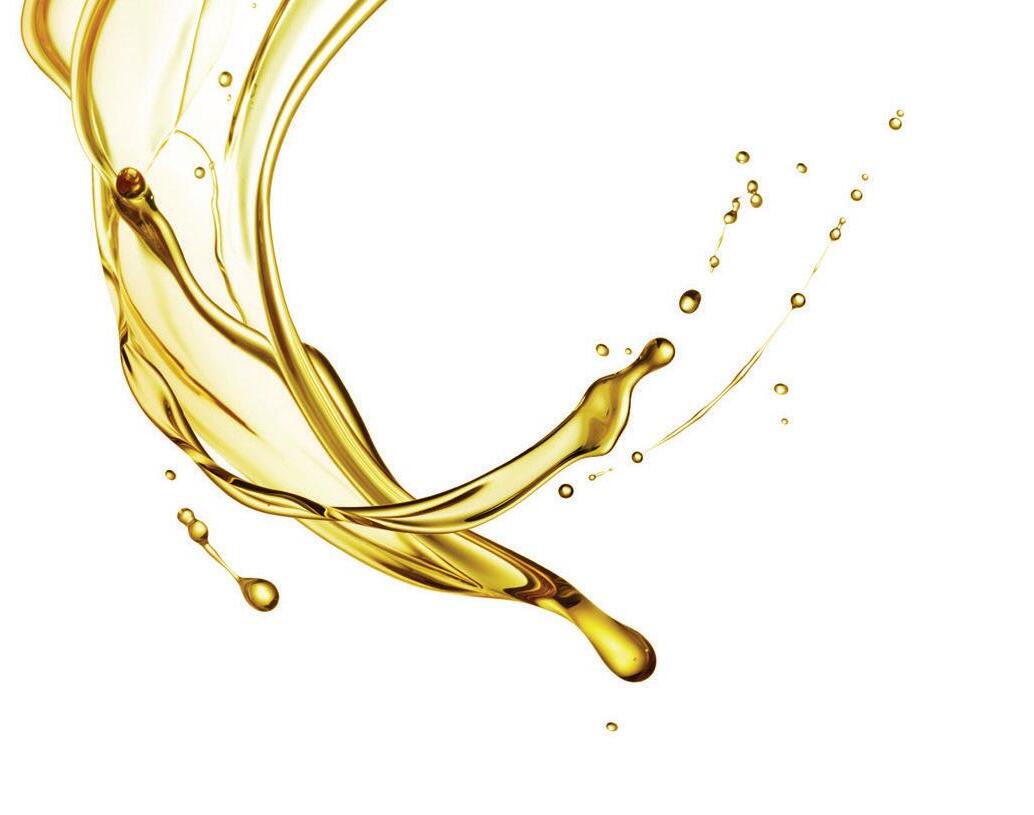


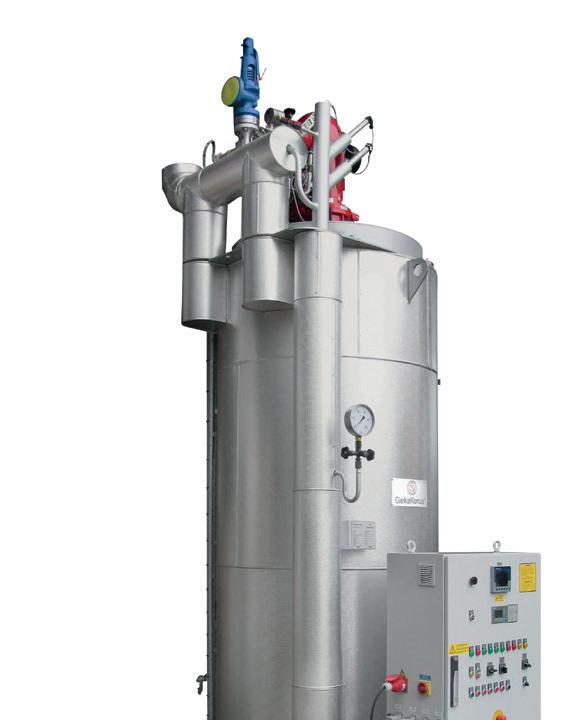


















Global oil giant Shell has announced it will be pausing construction at its 820,000 tonnes/year biofuels facility at the company’s chemicals park in Rotterdam, the Netherlands.
Shell subsidiary Shell Nederland Raffinaderij said the decision to halt construction at the site was made to address project delivery and ensure future competitiveness given current market conditions.
In a statement on 2 July, Shell said that following the decision to pause construction, “contractor numbers will reduce on site and activity will slow down, helping to control costs and optimise project sequencing”.
“Temporarily pausing on-site construc-
GERMANY: The government has approved the unrestricted sale of 100% renewable diesel (also known as HVO100) in the country as part of the DIN EN 15940 fuel standard, EuropaWire (EW) wrote on 29 May.
With this approval, Germany followed other EU countries such as Belgium, Finland, the Netherlands, and Sweden, where the sale of 100% renewable diesel at petrol stations was allowed, EW wrote. Sales of unblended, 100% renewable diesel in Germany had previously been restricted to specific segments, such as in nonroad vehicles and public transportation.
tion now will allow us to assess the most commercial way forward for the project,” Shell’s downstream, renewables and energy solutions director Huibert Vigeveno said.
“We are committed to our target of achieving net-zero emissions by 2050, with low-carbon fuels as a key part of Shell’s strategy.”
Given the go ahead by Shell in September 2021, the Netherlands plant was due to become operational in 2025, Reuters wrote on 2 July.
According to the report, the facility, which would produce sustainable aviation fuel (SAF) and renewable diesel from waste, was now expected to start produc-
tion towards the end of the decade. Biofuel prices had come under pressure in recent months due to weaker demand in Europe and rising supplies in the USA, Reuters wrote.
The market is expected to remain well supplied in the coming years as more production comes online, according to analysts quoted in the report.
Shell had warned investors that it would take an impairment charge of up to US$2bn in its second quarter results, due to be published in August, as a result of halting the Rotterdam plant and selling off its refinery and petrochemical assets in Singapore, The Guardian wrote on 5 July.

British multinational oil and gas company bp has announced it would be scaling back plans to develop new sustainable aviation fuel (SAF) and renewable diesel projects at existing sites.
In a statement on its website on 20 June, the company said it was pausing plans for two potential projects while continuing to assess three for progression.
Meanwhile, bp said it had agreed to take full ownership of its Brazilian joint venture bp
Bunge Bioenergia, acquiring global agribusiness giant Bunge’s 50% share of the industrial-scale sugarcane and ethanol company. The transaction was expected to close by the end of this year, subject to regulatory approvals.
As well as increasing the company’s production volumes of ethanol, bp said full ownership would also offer the potential for further growth opportunities in the region, with the chance to develop new platforms for bioenergy such as next generation ethanol, SAF and biogas.
Speaking about the developments in Brazil, Emma Delaney, bp’s executive vice president, customers and products, said the company had been an early entrant into the bioenergy business in Brazil and was looking forward to continuing to grow and develop there.
bp said its co-processing investment plans remained unchanged and it expected to more than double its biofuel production co-processing volumes to 20,000 barrels/day by 2025.
Leading global used cooking oil (UCO) producer China, will run out of waste oil due to demand from Europe and the USA outstripping supply, according to a 18 June report by clean transport campaign group Transport & Environment (T&E).
The report said Europe consumed 130,000 barrels/day (bpd) of UCO – eight times more than it collected, while US consumption totalled more than 40,000 bpd.
To fill the supply gap, both Europe and the USA were importing increasing ship-

ments of UCO from China, as well as from Indonesia and Malaysia, with China exporting more than half of its UCO capacity to the two regions.
In addition, worldwide SAF targets in 2030 would require at least twice the UCO that could be collected in the USA, Europe and China combined, the study found.
The report also showed further evidence of allegedly fraudulent UCO supplies from China, saying that while China’s collection capacity appeared to correspond to export
levels, a huge illegal gutter oil market meant the country was likely to be consuming significant volumes of UCO domestically. In addition, major palm oil producer Malaysia exported three times more UCO than it collected domestically.
T&E called for Europe to move away from industry-led voluntary schemes towards stricter EU and national UCO regulation and controls. It also urged governments to stop counting imported UCO in sustainability targets.














































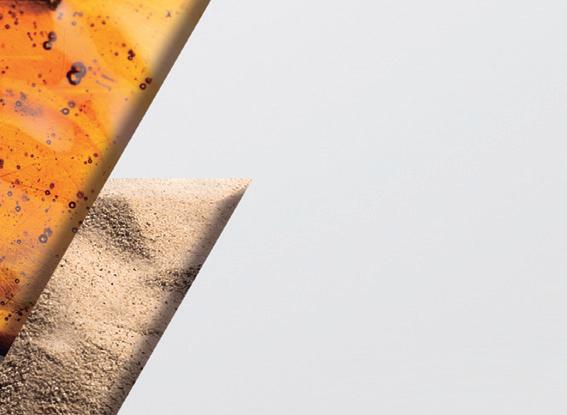














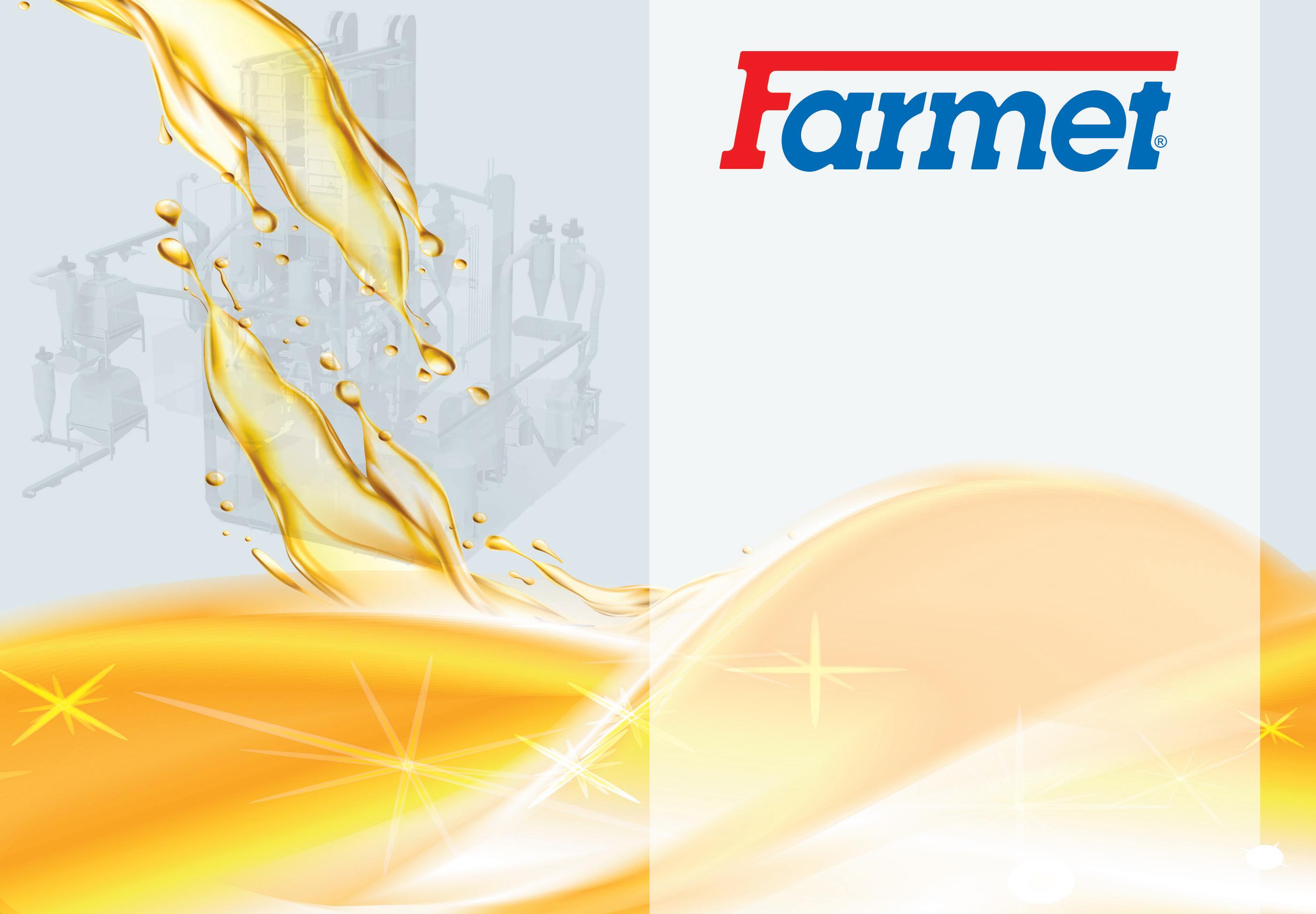
The effective technology and complex services
STATE-OF-THE ART OILSEEDS AND OIL PROCESSING TECHNOLOGIES
■ Horizontal agriculture
■ Local mechanical processing
■ Patented system of energy recovery
■ Complex approach including Physical Oil Re ning
■ Unique combination of extruders and screw presses
EUROPE: A research team has developed a new glue spray made from edible oils to trap plant pests as an alternative to synthetic pesticides, The Guardian wrote on 18 May.
Researchers from Germany’s Wageningen University & Research (WUR) and Leiden universities in the Netherlands oxidised vegetable rice waste oil to make it sticky and then mixed it with water and a small amount of soap to stop the droplets sticking together.
This solution was sprayed on strawberries and the leaves of chrysanthemum plants, the favourite food of thrips, a common pest which could attack more than 500 species of vegetable, fruit and ornamental crops, The Guardian wrote. During a two-day testing period, more than 60% of thrips were captured and the drops remained sticky for weeks. Field trials later this year would test the process at scale.
The WUR and Leiden researchers have applied for a patent to set up a spin-off company – expected to start by the end of this year – to commercialise the new pesticide with a focus on using a range of waste oils.
By making small adjustments to the process, any type of vegetable oil could be used to make the pesticide, the researchers said.
The cost of the sticky drop pesticide was uncertain as it was not yet known how much would need to be applied and how often.
Nick Mole, from Pesticide Action Network UK, said the research could result in a decrease in synthetic pesticide usage but more research was required to assess the impact on the environment and non-target insect species, The Guardian wrote.
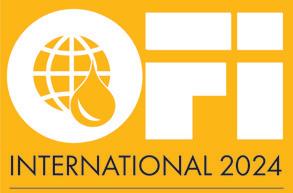
Global consumer goods giant Unilever is reducing the palm oil content in its soaps in India by 25% as part of a wider strategy to offset volatility in commodity prices and reduce environmental impact, the Economic Times wrote on 13 June.
Under its Indian subsidiary Hindustan Unilever (HUL), the fast-moving consumer goods company markets its Lux and Lifebuoy soap ranges in India.
Unilever took almost five years to develop its Stratos technology, which replaced palm oil with a mix of plant-derived polysaccharides, vitamin blends and natural fatty acids, the report said.
The technology would also be introduced in other countries, the Economic Times wrote.
In response, the Asian Palm Oil Alliance urged HUL to reconsider its decision, saying the move could impact millions of oil palm farmers worldwide, particularly smallholders.
In a 18 June The Edge Malaysia report, the alliance said commodity prices were influenced by demand and supply factors and that palm oil was no different.
With a 38% share of India’s soap market, HUL is the country’s leading soap supplier.
“Since there is less palm oil used, that allows us a huge amount of savings, which we can use to reinvest in other ingredients,” the Economic Times quoted HUL vice president, skin cleansing, Ankush Wadehra, as saying.
“A reduction in TFM (total fatty matter) certainly helps us in managing the inflation-deflation cycles of commodities.”
Palm oil and its derivatives accounted for over 20% of the input costs of consumer companies, including HUL, and were among the most volatile of their inputs, according to the Economic Times
Speciality chemical company Evonik has officially inaugurated its new triple-digit million-euro biosurfactants plant in Slovakia (pictured).
Based at the Evonik Fermas site in Slovenská Ľupča, the facility was the first in the world to produce industrial-scale quantities of rhamnolipids, Evonik said on 29 May.
“Rhamnolipids are increasingly in demand because they provide a sustainable alternative to surfactants based on fossil sources or tropical oils,” the company said.
They were fully biodegradable, with a low toxicological and ecotoxicological profile, and their foam-forming properties and mildness made them ideal for use in house-

hold cleaners and personal care products, Evonik said. They also had industrial applications such as in coatings, mining, and oil and gas.
Evonik produces its rhamnolipids from European corn feedstocks using a fermentation-based process.
German biotechnology company Insempra said on 7 May that it had raised US$20M in funding to expand production of yeast-fermented lipids for food and cosmetics, following an initial US$15M seed round in 2021.
Insempra uses a range of second-generation feedstocks such as lignocellulosic biomass (crop
Evonik Fermas was a joint venture between Degussa AG and Biotika before becoming a 100% subsidiary of Evonik in 1998 and expanding to produce fermentation-based products for animal nutrition, pharmaceuticals, cosmetics and personal care.
residues) in its fermentation process. The company said it was also developing technology to offer bio-based alternatives to everyday materials, such as polymers and textiles, and to create new natural molecules for use in functional ingredients, such as antioxidants, preservatives, flavours and fragrances.


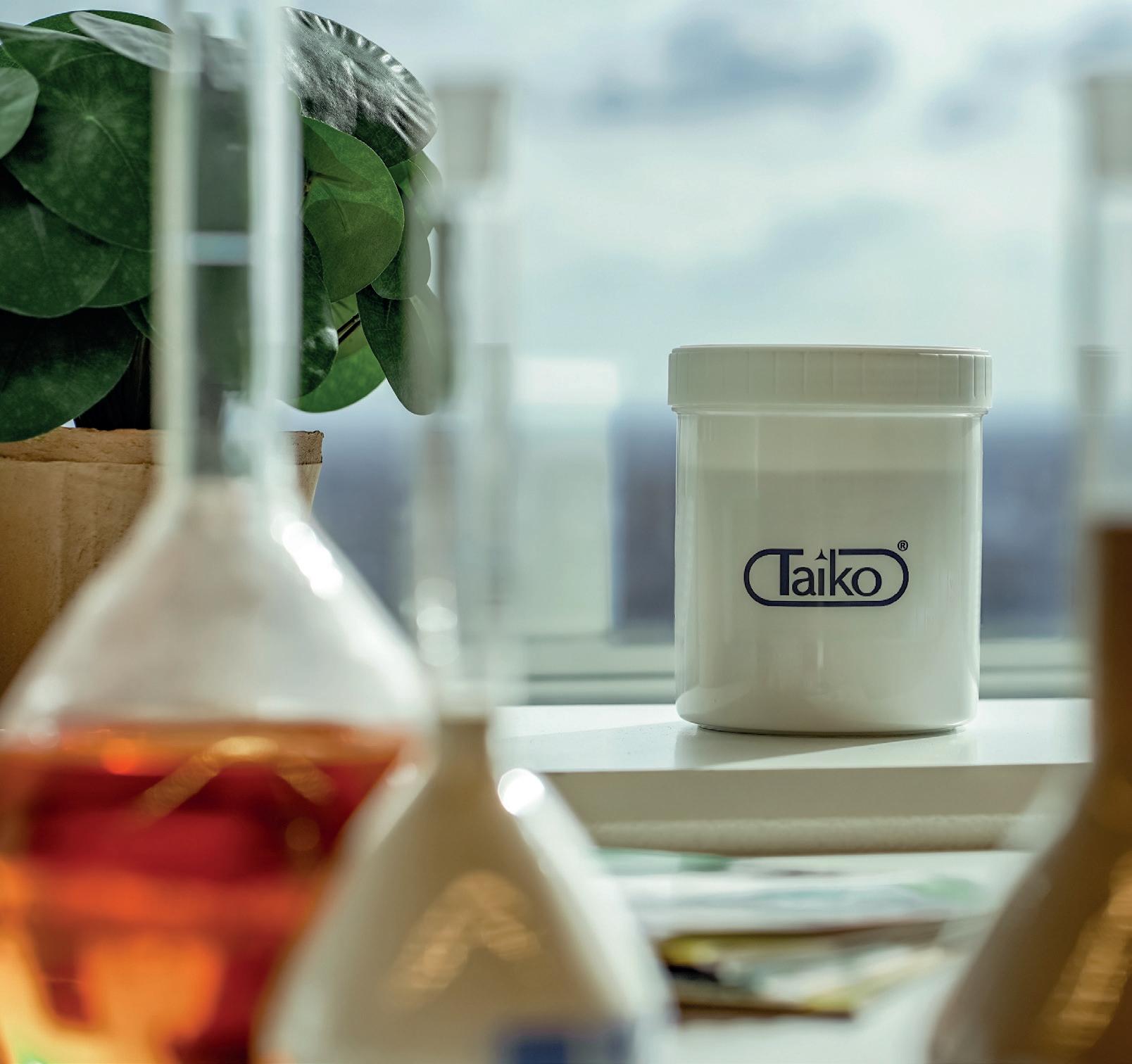
















Confirmed speakers include:
Thomas Mielke, Editor and CEO of Oil World
Elwin de Groot, Head of Macro Strategy, RaboResearch –Global Economics and Markets (GEM)
Caroline Midgley, Director of Oleochemicals and Biofuels Research, Agr i-business division, GlobalData
Darren Cooper, Senior Economist, International Grains Council (IGC)
Sven Kuhlmann, Vice President for the Production of Renewables, Neste, Finland
Veerle Vanheusden, PhD, Policy officer - Unit E2 – Food processing and novel food, Directorate General Health and Food Safety, European Commission
Kerstin Krätschmer, Wageningen Food Safety Research
Ludger Brühl, Max Rubner-Institut (MRI)


Agribusiness giant Bunge Global and Zen-Noh Grain Corp – the US subsidiary of Japan’s Zen-Noh Group – have agreed through a joint venture to buy a 50% stake in a grain terminal at the Port of Santos in Brazil, World Grain reported on 30 May.
The partners would hold an equal stake in the 135,000 tonne XXXIX grain terminal in the south of the country, according to the report, based on a Reuters article.
The companies had acquired the terminal from Brazilian rail operator Rumo for BRL 600M (US$115.3M), with the deal subject to regulatory approval.
THE NETHERLANDS:
Finnish renewable fuels producer Neste announced on 27 May that it had commissioned capacity at energy storage and infrastructure developer VTTI’s ETT terminal for the storage and blending of its sustainable aviation fuel (SAF).
VTTI’s terminal – sited at one of Europe’s largest fuel logistics hubs – would enable more sustainable and efficient fuel supply to customers and airports across Europe, Neste said.
THE NETHERLANDS: International liquid bulk storage company Koole Terminals Group announced on 19 June that it would now operate under the name Chane.
“The rebranding signifies a further unification of the company, after strengthening its position in the European liquid bulk storage market with the acquisitions of Alkion Terminals in 2022 and Maastank in 2023,” the company said.
Chane operates 22 tank terminals with a total capacity of 5.4M m3, located in seven countries – the Netherlands, France, Italy, Poland, Portugal, Spain and the United Kingdom.

Brazilian food and fuel processor Caramuru Alimentos, one of the country’s largest grain crushing companies, would continue to hold the remaining 50% share of the terminal, World Grain wrote.
Located on São Paulo state’s coastline, the Port of Santos is the largest in Latin America and the most important foreign trade route in Brazil, with almost 27% of the country’s trade balance (US$112.3bn) passing through the port, according to Santos Port Authority. The Port of Santos also handled around 30% of the country’s total soyabean exports, followed by Paranaguá
and Rio Grande ports, the authority said. Rumo, a Cosan subsidiary, provides transportation for agricultural commodities, fuels, fertilisers, corn, wheat, rice, soyabeans, sugar and industrialised products. It manages some 14,000km of railways in Brazil and operates nine trans-shipment terminals and six port terminals in the main Brazilian ports.
In March, Rumo and supply chain solutions provider DP World also reached an agreement to build a new port terminal for grains and fertilisers at DP World’s private-use terminal at the Port of Santos.
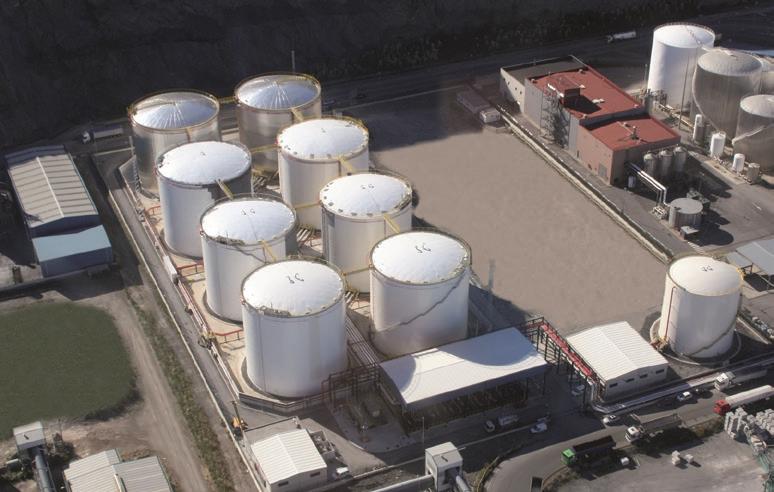
Spanish petroleum logistics firm Exolum announced on 29 May that it would invest US$218M in a new terminal for the storage of biofuel and bulk liquid products next to its facility in Zierbena at the Port of Bilbao.
The facility was expected to become operational in 2027 and would enable the receipt, storage, blending and dispatch of biofuels and
other alternative fuels and oils. It would be linked to Exolum facilities in Zierbena and Santurce and the company’s network in Spain.
The project’s first phase was due to start next year and would involve the construction of five tanks with a total storage capacity of 29,000m³. In subsequent phases, capacity and services would be increased by adapting logistics to the requirements of each raw material type.
Active in 11 countries, Exolum operates a 6,000km pipeline network, 69 storage terminals and 47 airport facilities, with a total storage capacity of more than 11M m³. In Spain, it manages three storage terminals in the municipalities of Santurce, Zierbena and Rivabellosa; has operations at Bilbao and San Sebastián airports; and operates a 152km pipeline connecting its three terminals with a petroleum refinery in Muskiz and the Port of Bilbao.
Leading Ukrainian agribusiness Nibulon says it will be modernising its entire grain elevator network in terms of automation, service unification and mechanisms.
“Volumes are growing,” Nibulon director for elevators operation Valeriy Reutsoi said on 29 May. “The elevator sector is the heart of agribusiness … and grain heading for export depends on its proper operation.”
Nibulon said it would also expand capacities at its Khmilnyk branch, AK Vradiivskyi and Kolosivskyi elevators, and Transshipment Terminal. US$3.9M would be invested at Khmilnyk branch, Vinnytsia region, including the second stage of elevator construction, new transport equipment, four silos and installation of two grain dryers to increase drying capacity up to 2,200 tonnes/day.
Investments at AK Vradiivskyi and Kolosivskyi
elevators in the Mykolaiv region would include changes to receipts and shipments, allowing several crops to be handled simultaneously at AK Vradiivskyi to reduce waiting times and doubling grain receipt at Kolosivskyi. At the Transshipment Terminal in Mykolaiv, US$720,00 would be invested to enable water transport cargo receipt and rail trans-shipment for delivery to Nibulon’s Bessarabska branch, reducing logistics costs to Izmail ports caused by the Russian blockade of the Mykolaiv port hub.
Nibulon is one of Ukraine’s largest grain and oilseed growers and processors, producing more than 320,000 tonnes/year of grain and oilseeds such as wheat, corn, barley, sunflower, soyabean and rapeseed. It runs its own fleet, has 2.25M tonnes of total grain storage capacity and operates 27 trans-shipment terminals in the country.

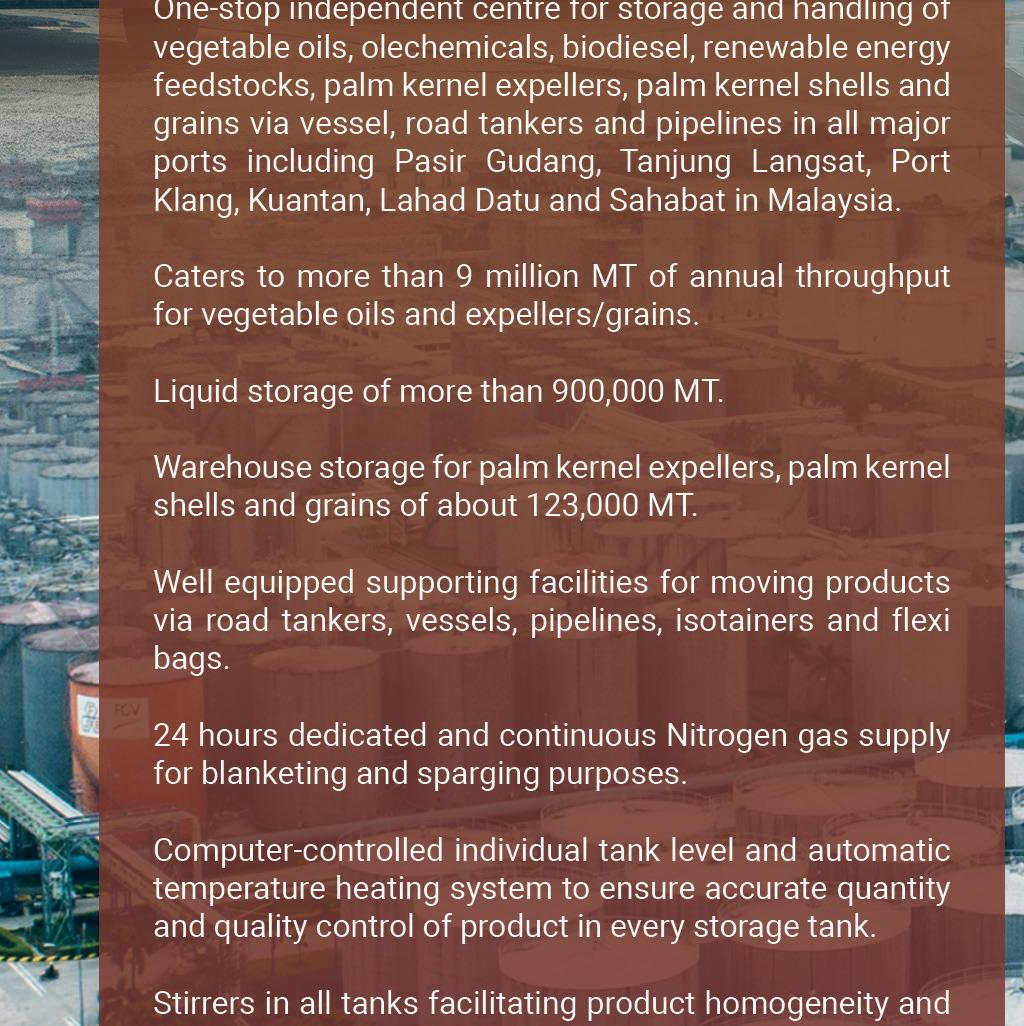







Global agribusiness giant ADM has expanded its facility in Mainz, Germany, with the addition of a new non-genetically modified (GM) soyabean processing facility.
ADM said the investment would increase the company’s ability to offer differentiated products and enable it to keep up with increasing demand in Europe for GM-free soyabeans.
“The expansion of capacity at our Mainz site and investment in new … processing facilities underscores the growing sig-
USA/UK: US agricultural bioscience firm Yield10
Bioscience announced on 17 June that Rothamsted Research, UK, had granted it an exclusive global licence to produce omega-3 oil and meal from GE camelina. The potential market for eicosapentaenoic acid (EPA) and docosahexaenoic acid (DHA) fatty acids produced from camelina included use in pharmaceutical products, dietary supplements, and food and feed ingredients, the company said.
ISRAEL: Castor cultivation firm Casterra Ag, a subsidiary of Israel’s Evogene, is set to expand its production of castor seeds in Africa after signing agreements with existing and new seed producers in the country.
The deals were expected to add approximately 500 tonnes to Casterra’s total castor production this year and reduce production risks, Casterra CEO Yoash Zohar said on 21 May. Casterra said it had developed its castor bean seeds from a collection of more than 300 castor lines, using Evogene’s plant genomics tools to enable industrial-scale production of castor beans to produce oil for use in bio-based industries, such as biopolymers and biofuels.
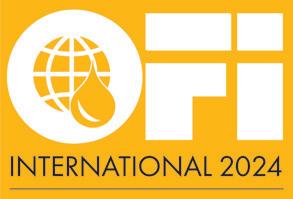
nificance of GM-free soyabeans within the German food sector,” ADM Straubing general manager Rene van der Poel said on 7 May. “This investment is a key component of our … growth strategy … to meet growing demand for non-GM and local products.”
In addition, the expansion of the Mainz facility would offer local farmers further incentives to increase their cultivation of nonGM soyabeans and integrate soyabeans into their crop rotation practices, ADM said.
The Mainz facility can process both GM and non-GM soyabeans and its expansion was part of ADM’s broader focus on strengthening its network of soyabean processing facilities across Europe, the company said.
“This enhancement allows us to produce a diverse range of products including soyabean oil for various industries, soyabean meal for food, feed, beverage and petrochemical applications, as well as biodiesel,” van der Poel added.
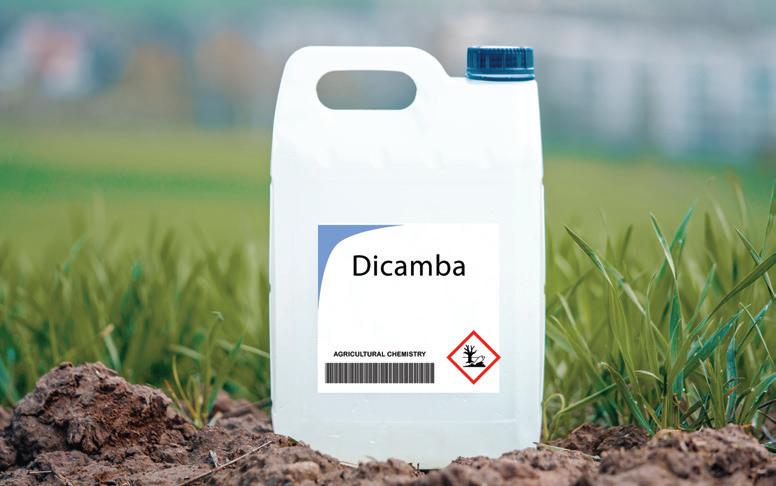
A US federal court decision blocking German chemical giant Bayer AG and two other companies from selling their dicamba herbicides could boost sales for Corteva Agriscience’s products, according to an industry source quoted in a May Des Moines Register report.
The US Environmental Protection Agency (EPA) issued an order barring Bayer, BASF and Syngenta Crop Protection from selling dicamba following a federal court ruling in February, although allowing farmers to use dicamba they had already purchased, the report said.
Environmental groups had opposed the EPA’s registration of dicamba products, claiming they drifted from fields when sprayed on soyabeans
and cotton, killing other crops and trees not genetically modified to be resistant to it, as well as pollinators like monarch butterflies and bees, Des Moines wrote. Bayer had reformulated dicamba, saying it had reduced its volatility and tendency to drift, but problems had continued, the report said.
Against this backdrop, Corteva had introduced a product that used 2,4-D, a 1940s herbicide that had been reformulated to avoid past drifting problems.
To date, the Corteva products have not experienced the regulatory troubles that dicamba had, according to analysts. The product also had fewer application restrictions compared to new dicamba products, the analysts said.
With more US agricultural land becoming resistant to glyphosate every year, farmers wanted more options, according to Seth Goldstein, a Morningstar Research Services analyst. “Farmers are looking for alternative soyabean seeds ... that don’t require dicamba or glyphosate use.”
Without dicamba-based products, BASF said farmers would lose up to US$10bn in soyabean and US$800M in cotton yields annually.
Global crop protection and seed company Syngenta Group announced on 4 June that it is opening rights to some of its genome editing (GE) technologies for academic research globally.
The rights related to optimised CRISPRCas12a and GE-enabled breeding tools and would be available through the ‘Shoots by Syngenta’ collaboration platform, created last year to bring together academics, research institutes and Syngenta’s network of more than 6,000 scientists to develop solutions that mitigated climate change and enhanced biodiversity, the firm said.
Syngenta Group is owned by Chinese state
enterprise Sinochem and has four business units – Syngenta Crop Protection, Syngenta Seeds, ADAMA and Syngenta Group China.
The Syngenta seeds business unit sells genetically modified (GM) seeds for corn and soyabean crops, with the percentage of company revenues generated from biotech seeds totalling some 6% in 2020, representing about 40% of global seeds sales, according to the company’s website.
Key countries where the group’s GM corn and/or soyabean seeds were cultivated included Argentina, Brazil, Canada, the Philippines, Vietnam and the USA, the group said.
1-2 August 2024
Palmex Thailand Suratthani, Thailand www.thaipalmoil.com
20-24 August 2024
21st International Sunflower Conference Bayannur, China www.esanrui.com/isc
28-29 August 2024
Palmex Malaysia Kuala Lumpur Convention Centre, Malaysia https://asiapalmoil.com
9-11 September 2024
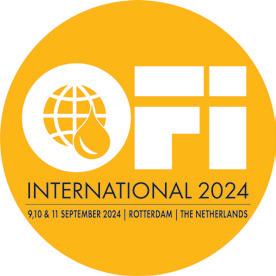
OFI International 2024
Rotterdam Ahoy Convention Centre, the Netherlands www.ofimagazine.com/ ofievent
11-13 September 2024
North American SAF Conference & Expo Saint Paul Rivercentre Saint Paul, Minnesota USA
https://saf.bbiconferences. com/ema/DisplayPage. aspx?pageId=Home
11-13 September 2024
Argus Sustainable Marine Fuels Conference Houston, Texas, USA https://www.argusmedia. com/en/events/conferences/ sustainable-marine-fuels
16-17 September 2024
6th International Symposium on Dietary Fat and Health Frankfurt, Germany https://veranstaltungen. gdch.de/microsite/index. cfm?l=11686&sp_id=1
16-18 September 2024
Argus North Amercia n Biofuels, LCFS & Carbon Markets Summit Monterey, California,USA www.argusmedia.com/ en/events/conferences/ north-american-biofuels-lcfscarbon-markets-summit
18-20 September 2024
Globoil India
The Westin Mumbai Powai Lake, Mumbai, India https://www.globoilindia.com
23-26 September 2024
19th GERLI Lipidomics
Meeting at the End of the World Plouzané, France
https://eurofedlipid.org/19thgerli-lipidomics-meeting-atthe-end-of-the-world
25-27 September 2024
Canadian Lipids and Proteins Conference Ottawa, Ontario
Canada
https://payments.carleton.ca/ canadian-lipids-and-proteinsconference-2024
30 Sept-2 Oct 2024
2nd Berlin Symposium on Structured Lipid Phases
Berlin, Germany
https://eurofedlipid.org/ofiinternational-2024-2
2-3 October 2024
4th ICIS Pan American Oleochemicals Conference
Ritz Carlton Coconut Grove Miami, USA
https://events.icis.com/ website/13907/
2-4 October 2024
Sustainable Aviation Futures
North America Congress Houston, Texas USA
www.safcongressna.com
For a full events list, visit: www.ofimagazine.com Information subject to change
9-11 October 2024
Palmex Indonesia Medan, Indonesia https://palmoilexpo.com/ index.html
15-17 October 2024
Argus Biofuels Europe Conference & Exhibtion London, UK www.argusmedia.com/en/ events/conferences/biofuelseurope-conference-andexhibition
22-23 October 2024
Oil and Fats International Congress (OFIC) 2024 (+ Online)
Kuala Lumpur Convention Centre, Malaysia https://mosta.org.my/events/ ofic-2024
22-26 October 2024
2024 North American Renderers Association Annual Convention
Ritz Carlton Bacara, Santa
Barbara, USA
https://nara.org/about-us/ events
4-6 November 2024
Sustainable Aviation Futures APAC Congress
PARKROYAL Marina Bay, Singapore www.safcongressapac.com
7-9 November 2024
5th YABITED Fats and Oils Congress
Antalya, Turkey www.yabited2024.com/EN/ Default.aspx
12-14 November 2024
Global Grain Geneva 2024 Geneva, Switzerland www.fastmarkets.com/ events/global-grain-geneva
14-15 November 2024
Biofuels Expo 2024
Renaissance London Heathrow Hotel, UK
https://biofuelsconference.org







www.ofimagazine.com
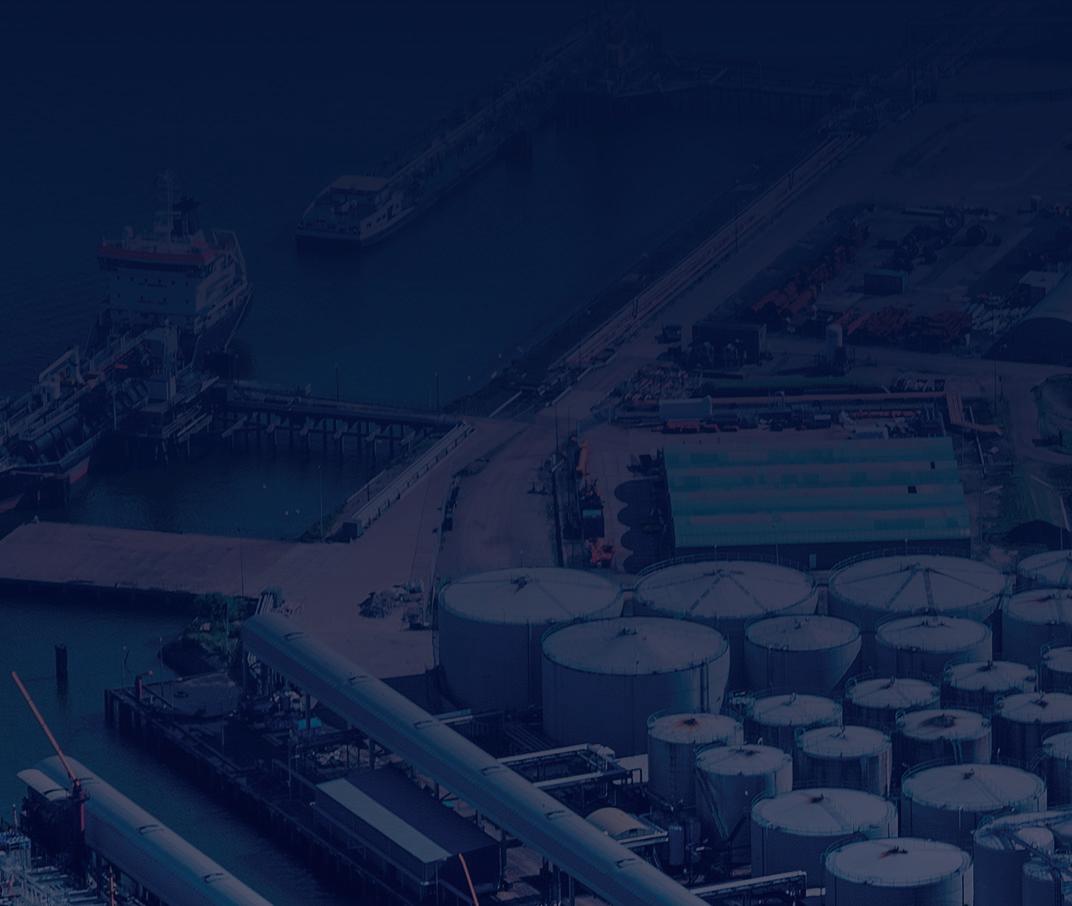



















































































































































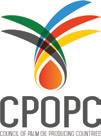







Brought to you from the same team behind the leading global magazine, Oils & Fats International (OFI) is delighted to announce the launch of OFI International 2024, to be held at the Rotterdam Ahoy Convention Centre on 9-11 September 2024.
OFI International 2024 will bring together major players across the European, Asian and global oils and fats community under one roof, with a focus on ‘Solutions for Sustainability, Processing & Trade’.
9-11 SEPTEMBER 2024 | ROTTERDAM AHOY CONVENTION CENTRE
09 SEPT 2024
Site visits & port tours
Port of Rotterdam (subject to availability –places are limited)
The Port of Rotterdam is one of the world’s key trading hubs, housing six vegetable oil refining complexes, four biofuel manufacturers, and four oils and fats storage terminals.
As part of OFI International 2024, site visits will be organised to some of the major companies located in the port, giving delegates first-hand experience of their operations.
OFI Technical Commercial Conference
Rotterdam Ahoy Convention Centre
A two-day Technical Commercial Conference with the theme, ‘Innovations in Processing & Refining – Addressing Sustainability and Traceability Challenges in the Supply Chain’.
With oils and fats processors facing increasing pressure to maximise yields in the most competitive and sustainable way, this two-day conference will focus on the latest refining, and processing technologies, addressing latest industry issues on sustainability, waste feedstocks and contaminants such as MCPDEs, GEs, MOSH/MOAH, chlorinated paraffins and other persistent organic pollutants (POPs).
18.00 – 19.30
Rotterdam Ahoy Convention Centre 10-11 SEPT 2024 11 SEPT 2024
Rotterdam Ahoy Convention Centre
A two-day exhibition of major suppliers to the oils and fats industry.
• The Evening Welcome Reception at the Ahoy Rotterdam on 9 September
• OFI Technical Commercial Processing & Refining Conference on 10-11 September
• OFI Trade Outlook and Logistics Conference on 11 September
OFI Trade Outlook and Logistics Conference
Rotterdam Ahoy Convention Centre
This one-day conference under the theme ‘Managing Risks and Building Supply Chain Resilience’ will focus on current and future price trends impacting the world’s major vegetable oils including war and climate impacts on shipping; and what traders and producers must do to meet sustainability regulations such as the EU Deforestation Regulation (EUDR) and the EU Union Database Biofuels (UDB).
• The OFI International 2024 Exhibition on 10-11 September
• Daily delegate lunch and refreshments
• The opportunity to join a company tour at the Port of Rotterdam (subject to availability)
09:00 – 09:05 Welcome from organisers and opening remarks from the conference chair
Chair: Kevin Warren Smith, Chairman, Lipids Group of the Society of Chemical Industry and Lipid Scientist, Fat Science Consulting
09:05 – 09:35 Processing and refining from the producer’s perspective and the use of waste feedstocks – the Neste experience
Sven Kuhlmann, Vice President for the Production of Renewables, Neste, Finland
09:35 – 10:05 Sustainable approaches to oils and fats processing and refining
Gabriele Bacchini, Global Sales Director, CMB, Italy
10:05 – 10:35 Special refining of low-grade oils for food and fuel consumption
Andrea Bernardini, Commercial Director, Technoilogy, Italy
10:35 – 10:45 Q&A with speakers
Chair: Kevin Warren Smith, Chairman, Lipids Group of the Society of Chemical Industry and Lipid Scientist, Fat Science Consulting
10:45 – 11:30 Networking break
11:30 – 12:00 Production and processing of renewable diesel (HVO) and Sustainable Aviation Fuel (SAF)
Priscilla Costa, Sales & Business Development Manager, Renewable Fuels, Crown Iron Works, USA
12:00 – 12:30 Press-Oil Clarification and Lecithin Production. The secret‘s in the process: The link between press-oil-clarification and Lecithin production
Patrick Schuermann, Application Sales Manager for Renewable Resources, GEA
12:30 – 13:00 Designing bleaching earths and activated carbon – the science and art
Dr Pat Howes, Technical & Marketing Director, NATURAL BLEACH SDN BHD
13:00 – 13:10
Q&A with speakers
Chair: Kevin Warren Smith, Chairman, Lipids Group of the Society of Chemical Industry and Lipid Scientist, Fat Science Consulting
13:10 – 14:40 Lunch
14:40 – 14:50 Opening remarks from the conference chair
Chair: Paolo Telles, Fats & Oils Processing Specialist
14:50 – 15:20 Optimising filtration in the bleaching process
Bart Scholten, Group Business Development Manager, Envirogen Group, The Netherlands
15:20 – 15:50
The role and benefits of enzymatic deep degumming for various feedstocks in biofuel production
Jorge Moreno, Product Application Expert & Technical Service Manager, EMEA, dsm-Firmenich
15:50 – 16:20 Networking Break
16:20 – 16:50
Speciality fats - new crystallisation and separation technologies to improve melting technologies.
Dr Veronique Gibon, Consultant, Artemis Lipids by VG, Belgium
16:50 – 17:20
17:20 – 17:30
The growing demand for waste feedstocks - optimising yields and energy efficiency in rendering
Björn Schlüter, Sales & Service Director, HF Press+LipidTech, HarburgFreudenberger Maschinenbau GmbH
Q&A with speakers and closing remarks from the conference chair
Chair: Paolo Telles, Fats & Oils Processing Specialist
08:55 – 09:00 Welcome from the conference chair
Chair: Kevin Warren Smith, Chairman, Lipids Group of the Society of Chemical Industry and Lipid Scientist, Fat Science Consulting
09:00 – 09:30 The state of play of the activities of the European Commission on mineral oil hydrocarbons in food (remote presentation)
Veerle Vanheusden, PhD, Policy officer - Unit E2 – Food processing and novel food, Directorate General Health and Food Safety, European Commission
09:30 – 10:00 Ensuring the safety and quality of fried goods with a focus on formation of arcylamide and trans fatty acids – latest regulations and developments
Dr. Ludger Brühl, Department of Safety and Quality of Cereals, Max Rubner-Institut (MRI), Germany
10:00 – 10:30 Chlorinated paraffins – the latest contaminant of concern
Dr. rer. nat. Kerstin Krätschmer, Project Leader Scientist, Wageningen Food Safety Research, the Netherlands
10:30 – 10:45 Q&A with speakers
Chair: Kevin Warren Smith, Chairman, Lipids Group of the Society of Chemical Industry and Lipid Scientist, Fat Science Consulting
10:45– 11:30 Networking break
11:30 – 12:00 MOSH/MOAH origins and mitigation in the supply chain
Michele Marazzato, Process Development Scientist / R&D Lead Contaminants, Cargill Global Edible Oil Solutions
12:00 – 12:30 MOSH/MOAH in coconut oil
Speaker TBC, Philippines Coconut Authority (PCA)
12:30 – 12:40 Q&A with speakers and closing remarks from chair
Chair: Kevin Warren Smith, Chairman, Lipids Group of the Society of Chemical Industry and Lipid Scientist, Fat Science Consulting
12:40 – 14:10 Lunch
14:10 – 14:15 Opening remarks from the conference chair
Chair: Paolo Telles, Fats & Oils Processing Specialist
14:15 – 14:45
14:45 – 15:15
Mitigation of MCPDEs, glycidyl esters (GE) and MOSH/MOAH and in edible oils – latest processing and refinining strategies
Antonios Papastergiadis, Senior R&D Engineer and Laboratory Manager, Desmet
Recent developments in analysis of processing and environmental contaminants in edible oils and fats including MOSH/MOAH and Persistent Organic Pollutants (POPs)
i. A. Dr. Torben Küchler, Health and Nutrition, Food Chemist / Product Manager, SGS, Germany
15:15 – 15:25
Q&A with speakers
Chair: Paolo Telles, Fats & Oils Processing Specialist
15:25 – 15:55 Networking break
15:55 – 16:25 Interpretation of processing contaminant analysis, including MOSH/MOAH
Dr. Payam Aqai, QTI Services, the Netherlands
16:25 – 16:55
16:55 – 17:05
Analytical perspective of MCPD esters and glycidyl esters in processed food
Ian de Bus, PhD, Project Lead Organic Contaminants, Wageningen Food Safety Research (WFSR)
Q&A with speakers and closing remarks from the conference chair
Chair: Paolo Telles, Fats & Oils Processing Specialist
This one-day conference will focus on current and future price trends impacting the world’s major vegetable oils; and shipping and logistical challenges affecting the cost of trade, as well as the impact of new sustainability regulations on producers and traders.
CURRENT AND FUTURE MARKET TRENDS FOR VEGETABLE OILS
09:00 – 09:05 Welcome from organisers and opening remarks from the conference chair
Chair: Frans Claassen, Managing Director, MVO
09:05 – 09:35 Global vegetable oil market –current prices and future trends
Thomas Mielke, CEO, Oil World
09:35 – 10:05 World markets for soyabeans: observations and expectations for the year ahead
Darren Cooper, Senior Economist, International Grains Council (IGC)
10:05 – 10:35 Regional oil market developments: India and China
Tim Worledge, Editorial Director, Fastmarkets
10:35 – 11:05 Black Sea vegetable oils trade – update on Ukraine and Russia and Ukraine’s export corridors
Sergey Feofilov, Director General, UkrAgroConsult, Ukraine
11:05 – 11:15 Q&A with speakers
Chair: Frans Claassen, Managing Director, MVO
11:15 – 12:00 Networking break
SUPPLY CHAIN RESILIENCE IN SHIPPING
12:00 – 12:30 The impact of climate and geopolitical risks on oilseeds and vegetable oil trade flows
Elwin de Groot, Head of Macro Strategy, RaboResearch – Global Economics and Markets (GEM)
12:30 – 13:00 Trends in palm and soft oil freight rates
Francesco Morici, Chartering, Navquim Spain
13:00 – 14:00 Lunch
14:00 – 14:30
14:30 - 15:00
The Port of Rotterdam - key vegetable oil hub - and future challenges
Kesih van den Berg, Business Manager Bulk Cargo and Shipping, Port of Rotterdam
The shipping market, an owner’s perspective
Nils Jørgen Selvik, VP Corporate Analysis & IR, Odfjell SE
15:00– 15:15
Q&A with speakers
Chair: Frans Claassen, Managing Director, MVO
15:15 – 15:45 Networking break
SUSTAINABILITY & TRACEABILITY IN THE SUPPLY CHAIN
15:45 – 16:15
16:15 – 16:45
EU sustainability demands – a round-up of EU policies, feedstock pressures and the availability of used cooking oil (UCO) and tallow
Rohaise Low, Director of Oleochemicals and Biofuels Research, Agri-business division, GlobalData, UK
The EU Deforestation Regulation (EUDR) – meeting sustainability requirements
Allison Kopf, CEO, TRACT
16:45 – 17:15
17:15 – 17.45
Palm oil and the EU Deforestation Regulation (EUDR): A new Roundtable on Sustainable Palm Oil (RSPO) traceability system for enhanced trade and regulatory compliance
Ruben Brunsveld, Deputy Director
Market Transformation EMEA, RSPO
Soyabean oil and the EUDR
Gustavo Idigoras, President, Chamber of Vegetable Oil Industry of Argentina (CIARA)
17:45 – 18.00
Q&A with speakers and closing remarks from the conference chair
Chair: Frans Claassen, Managing Director, MVO



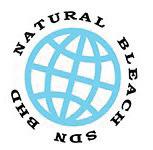




































Global vegetable oil consumption has risen by more than 10% over the past five years and this upward trend is likely to continue. However, with little significant growth in the output of palm, rapeseed and sunflower oils, the world will be heavily dependent on soyabean oil to meet demand in the season ahead
John Buckley
Global consumption of vegetable oils has increased by about 10.7% over the past five years, amounting to over 21M tonnes of extra demand (see Figure 1, right).
Growth might have been greater still if not for the negative period starting in the 2021/22 season, when COVID disrupted logistics and the conflict in Ukraine, which helped drive up the costs of many food commodities, including vegetable oils, to record highs.
The market made up for that with a stellar 8.4M tonne rebound in oil consumption in 2022/23, despite all the problems arising from the war between the world’s two largest sunflower oil suppliers, Russia and Ukraine.
The 2023/24 season now drawing to a close is expected by the US Department of Agriculture (USDA) to see only a moderate dip in the demand growth rate for vegetable oils, at 7.55M tonnes. For the new marketing year starting in October, expansion is forecast at just over 6M tonnes.
Where has demand been growing fastest? Five principal outlets have accounted for over 89% of total world demand over the past five-year period.
Indonesia comes out a clear leader, adding a staggering 8.2M tonnes of growth. One of the world’s most populous nations, its food oil consumption – on the back of economic development and population growth – has been a factor. Even more important, though, has been the country’s soaring use of its palm oil for biofuel, currently forecast to take another big
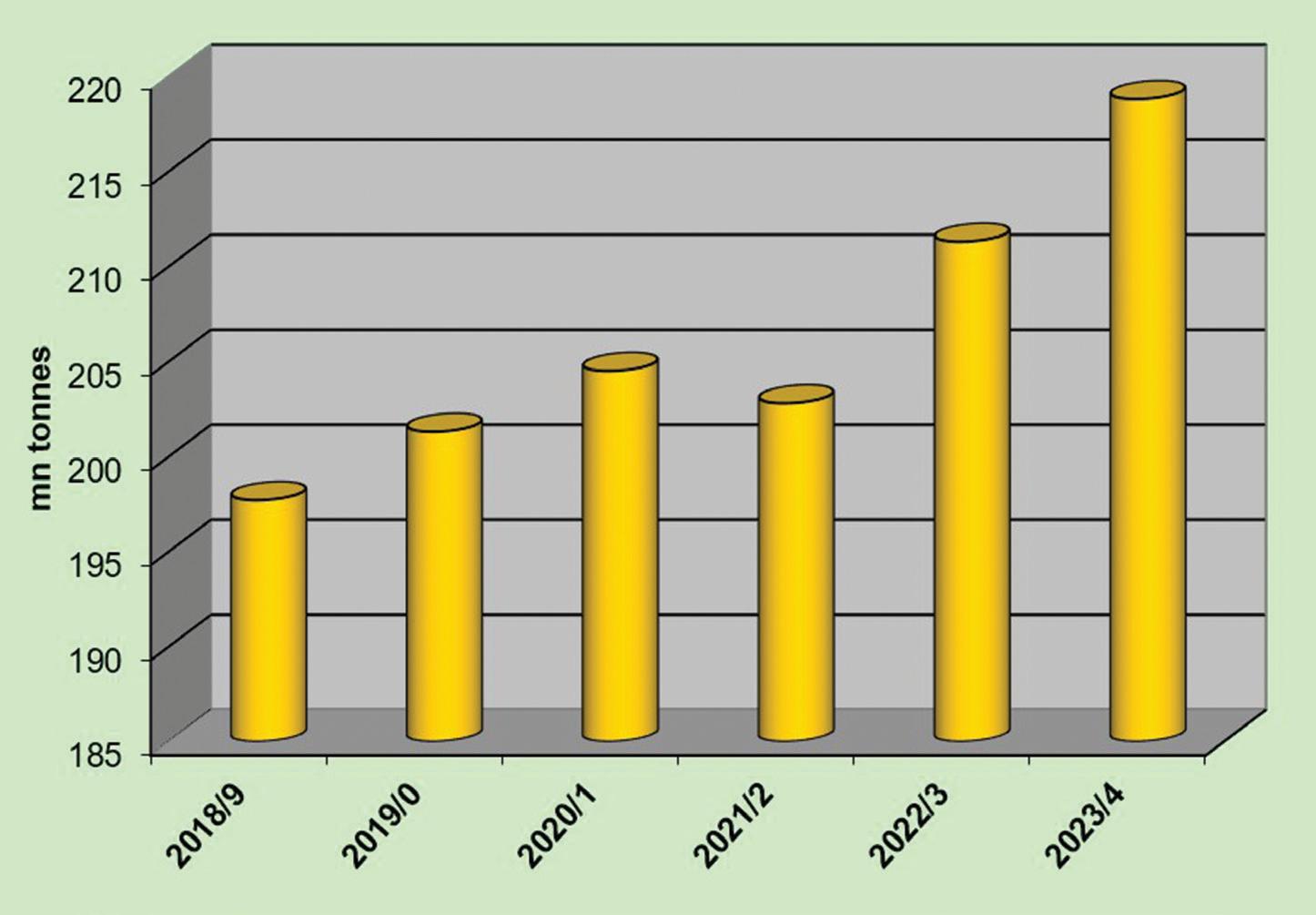
step up in the year ahead with a planned 40% blend rate of palm oil in biodiesel.
Amid an accompanying slowdown in its palm output expansion, Indonesia’s own growing usage clearly has implications for the world’s largest palm oil supplier’s future exports, growth of which has already stagnated after a sharp drop during the 2021/22 COVID season.
In second place on the consumption growth list is the one-time world leader in soyabean oil exports, the USA.
Once thought a ‘mature’ market, the USA has added over 4M tonnes to its total vegetable oil demand over the five years, accelerating in the past two seasons. Again, biofuel demand is boosting growth and there seems plenty more to come from this direction, especially for home-grown soyabeans and imported rapeseed oil.
Not surprisingly – in terms of their vast populations and economic development –India and China are still key components of the top five growth markets for vegetable oils – up about 2.5M and 2M tonnes respectively over the full five-year period. However, in contrast to the USA, the two countries’ consumption growth is still centred mainly on food oil.
Finally, Brazil has added about 2.1M tonnes of vegetable oil demand since 2018/19, also accelerating for the past two seasons after the 2021/22 slowdown. Here too, growing use of soyabean oil in the fuel sector has been a key factor.
For the season ahead, the USDA data
assumes that the big five growth countries will continue their consumption uptrend, with China adding 1.16M tonnes, the USA 0.92M tonnes, India 0.79M tonnes, Indonesia 0.78M tonnes and Brazil 0.55M tonnes. These big five countries in total will account for about 70% of world total vegetable oil consumption growth.
As in past years, the question remains –will the supply be there to meet foreseen demand at a reasonable cost?
In the past five-year period, four leading oils met most of the consumption growth – palm oil at 6.5M tonnes, soyabean oil at 6.2M tonnes, rapeseed oil at 5.4M tonnes and sunflower oil at 2.7M tonnes.
Soyabean oil is well in the lead for the 2024/25 season, expected to add 3M tonnes to world oil production, followed by palm oil at a mere 700,000 tonnes, quite a shift from past decades when rapidly expanding oil palm plantations were a key factor in keeping global vegetable oil prices in check.
For rapeseed and sunflower oils, there is little appreciable growth on the cards.
The small balance of extra supply is expected to come mainly from cottonseed, olive and peanut oils.
The likely heavy dependence on soyabean oil supply growth has kept its crop developments in sharp focus over the late spring and early summer months, during which the market has absorbed a mix of good as well as less encouraging news.
Higher soya crop and stocks
Bullish news has come from all the leading soyabean producing countries. Floods and other weather issues have hit Brazil and Argentina but both still expect largerthan-usual crops.
Some erratic planting and early growing conditions have also been seen in the USA, although the current crop outlook there is very promising.
In effect, increases in planted area in Brazil appear to more or less offset some likely decline in its yields from initial estimates. For Argentina, a return to more normal yields from the recent drought year is likely to ensure a more than adequate crop. In the USA, the still relatively favourable returns from soyabeans versus their old land rival corn has led to an estimated 3.5% increase in sowings which, if current yield pointers hold good, suggest a big crop rebound from last year’s disappointing 113M tonnes. If the crop stays on course, the USA should not only raise crushing but export significantly more soyabeans and products as well.
Recently, the soyabean supply outlook, and expected Latin American competition, has put Chicago soyabean futures on a steep downward curve towards four-year lows. However, the products have held up relatively well, thanks in part to soyabean oil’s support from the robust biofuel outlook.
Despite expected strong demand growth, at this stage, the soyabean market is still expected to build stocks quite substantially during 2024/25 for a third year running. That could put the global stocks total as high as 35.5M tonnes or 38% more than the 2021/22 carry-out low of 92.6M tonnes.
Against this backdrop, the USDA expects a decline in US domestic soyabean prices (11.6% down last season) will continue at a similar (10.8%) pace in 2024/25.
Soyabean oil prices are also expected to ease somewhat, with the 2024/25 season average currently projected at US$0.42/lb compared with the past season’s US$0.48/ lb and the 2022/23 average of US$0.65. Average US soyabean meal prices are, meanwhile, forecast to fall to US$330/ tonne against the past season’s US$380/ tonne and 2022/23’s US$452/tonne.
Floods hit the Brazilian soyabean crop coming into mid-harvest and earlier crop predictions of 163M tonnes (against last year’s 162M tonnes) have recently
been slashed by most analysts closer to 152/153M tonnes. The usually conservative government body CONAB recently forecast only just over 147M tonnes. The quality of later wet-harvested soyabeans could as well be affected.
Brazil’s soyabean and product costs could also be hoisted by planned tax changes, raising the export price.
While better Brazilian output is predicted for the subsequent 2024/25 season, with a USDA forecast of 169M tonnes, planting is months away and subject to unknown weather, making the figure somewhat speculative.
These factors might help the USA fare
a little better on soyabean exports than it expected a few months ago. However, a bigger issue for the US market may be where top soyabean importer China places its custom.
With frequently cheaper offers and fewer political handicaps than the USA, Brazil has been winning the bulk of Chinese demand for some time and, as we went to press in mid-July, has only just placed its first forward order for US new crop soyabeans.
Reduced Chinese demand for last year’s US crop has been a factor in lowering US total exports (to all destinations) some 16% down on those seen this time last year.




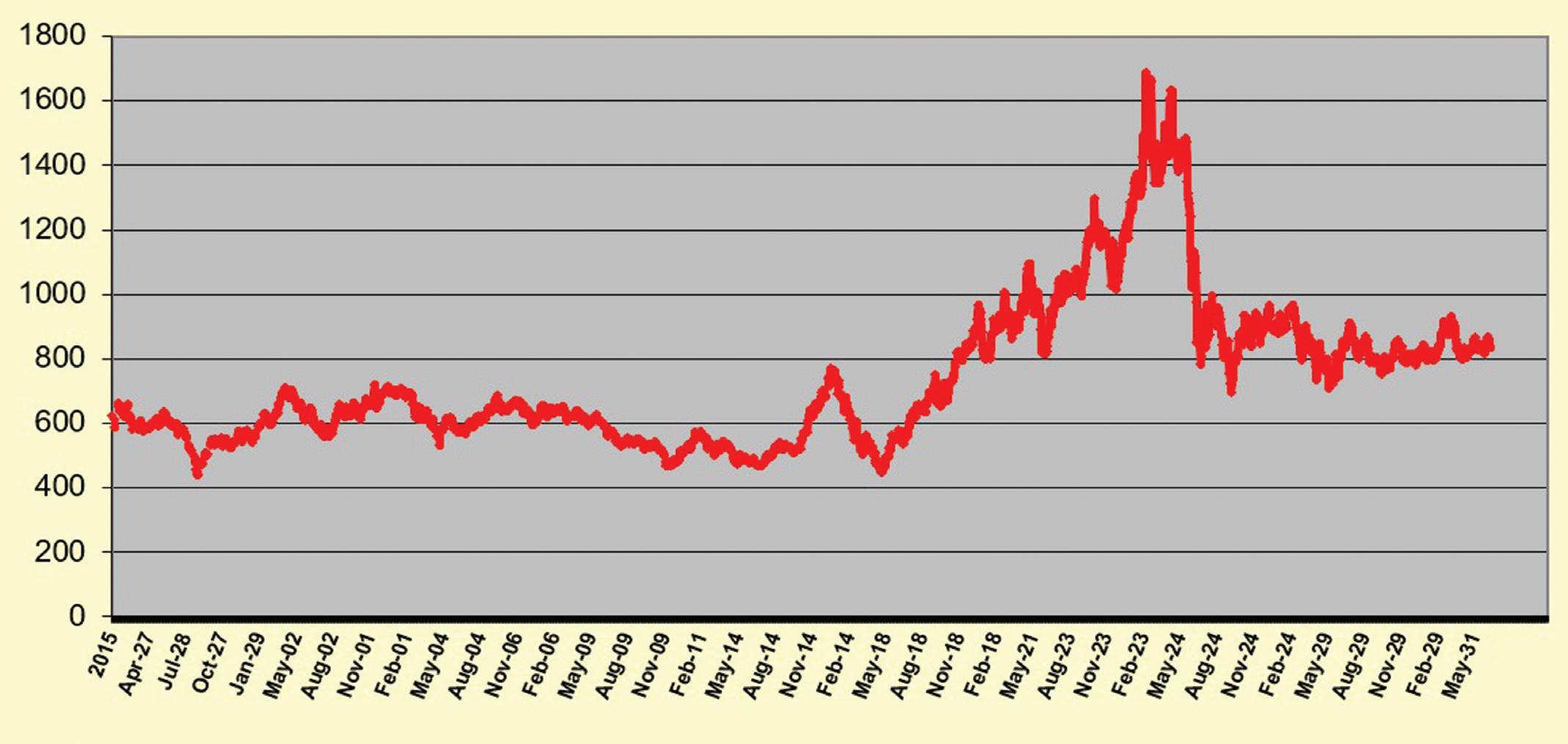
Will that situation change in the new 2024/25 season starting 1 September, let alone after the current volatile US presidential election outlook?
Argentine 2023/24 soyabean crop forecasts have also been trimmed recently but production should still be good –around 50M tonnes – a figure the USDA expects to see repeated next season.
Currently, analysts are forecasting a higher Argentine crush that should allow it to increase product exports, countering to some extent, Brazil’s lower-thanexpected crop and the possible export tax changes.
Palm’s contribution to world vegetable oil supply growth seems likely to continue to be smaller than the market has been used to for much of the past decade or two.
Plantation expansions have slowed and some weather upsets linked to the El Niño/La Niña climate cycle have been affecting both major producers, Indonesia and Malaysia.
Plantations also appear to be still in recovery mode after weather and COVID labour shortages of recent seasons.
Replanting schemes with their potential for higher yields can make a contribution to supply growth, along with more switching from smallholder to organised plantations. But for the next few years at least, this market may have to pin its hopes for increased supply on compliant weather improving yields.
Despite the slowdown in output growth, palm oil prices have been under some pressure recently from slowing exports and building stocks in Malaysia –the latter not unusual as production starts
its seasonal recovery.
Dealers and analysts have also cited the unusually narrow discount offered by palm against soyabean and sunflower oils, both recently picking up more business in pricesensitive importing countries like India.
A quick glance at the other main oil sources suggests rapeseed output could be down a little from last season at around 87M tonnes as potential gains in Canada are offset by lower harvest areas in Europe and Ukraine.
Hopes that previously up-and-coming exporter Australia might contribute more have retreated, with its current crop now forecast slightly below last year’s 5.7M tonnes. That may prove too pessimistic as yields might benefit from a retreating La Niña system usually favouring normal, rainfall. In 2022/23, Australia produced a record 8.27M tonnes after good rains boosted yields.
Canadian rapeseed values have rallied off their February lows on the Winnipeg futures market but softened more recently on hopes of a moderate 2024 crop increase.
The European market has recently looked firmer, however, as traders absorb acreage cuts in France and Germany, forced mainly by difficult planting weather and some flooding. The outlook for a smaller Ukrainian contribution to supply (with a lower harvest area and potential lower yields as well) has also helped firm EU values. However, Russia’s output is current seen close to last year’s 4.2M tonnes, which may help.
So far, large Asian consumers China and India appear to be heading for adequate
rapeseed crops.
A key issue still to fully unravel in the rapeseed market is the rising demand from the biofuel sector, with its heavy focus on trade flows from Canada to the USA.
Despite a probable pause in its planned crop expansion this year, Canada is expected to produce, crush and export more rapeseed in the medium to longer term. It has also been exporting less to the once dominant Chinese market.
Global sunflowerseed production could edge ahead of last year’s just-under 55M tonnes harvest if there are EU gains resulting from expanded plantings. Better weather recently may help this sunshinedependent crop if the soggy season continues to dry out in Western Europe. Russia and Ukraine have been forecast to produce moderately larger crops on slightly larger areas, provided recent dryness issues have not undermined yield prospects. Ukraine’s contribution, as usual, also remains hostage to potential disruption from its war with Russia, although its past season’s performance seems to have turned out a bit better than expected.
The FAO food price index was steady in June after three months of gradual rises and was still 2.1% below its June 2023 level and 25% below its March 2022 peak. While cereals were down by 3%, the average cost of vegetable oils was a bullish component, rising 3.1% on increasing biofuel demand in the Americas. Although the June FAO vegetable oil average was almost 14% above its June 2023 level, this was still well down from its 2022 peak.

Tunisia is the largest olive oil producer outside the EU. With
presidential elections this year amid a troubled economy, what are the prospects for the oils and fats sector and the country?
Serena Lim
Tunisia is a small country in North Africa with a young and growing middle class population driving an expanding food industry.
However, the country’s economy has faced significant challenges since its transition to democracy after the Arab Spring in 2011, with sluggish economic growth, and high unemployment and inflation.
The country is the largest producer of olive oil outside the EU and the fourth largest in the world after Spain, Italy and Greece, according to a Malaysian Palm Oil Council (MPOC) 2023 report.
Olive oil production has averaged around 228,000 tonnes/year over the past half decade, including a record 440,000 tonnes in the 2019/20 crop year, according to data from the International Olive Council (IOC).
However, Tunisia’s oilseed production remains insignificant. Although the
Ministry of Agriculture encourages Tunisian farmers to grow rapeseed and sunflowerseed crops, no formal programmes support diversification, says the US Department of Agriculture (USDA) Foreign Agricultural Service (FAS) Tunisian Oilseeds and Products Annual, published in March this year.
One plan to increase rapeseed area was reported by Milling Middle East & Africa in March 2023. Spearheaded by the Tunisian Union of Agriculture and Fisheries (UTAP) in partnership with Carthage Grains, the goal was to increase the cultivated rapeseed area to 140,000ha from the current 15,000ha over the next seven years but lack of rainfall was identified as the main obstacle in developing oilseed cultivation.
With a population of some 12M people, Tunisia is a net importer of vegetable oils. Tunisia’s edible oils and fats consumption consists of soyabean oil (57%), palm oil (21%) and olive oil from domestic production (9%), according to the MPOC report. Total consumption was estimated at 307,000M tonnes in 2022.
Despite the country being a major olive oil producer, only between 15%-20% is consumed domestically, with olive oil increasingly replaced by other vegetable oils in the traditional Tunisian diet, the MPOC report says.
“Olive oil is relatively expensive and thus unaffordable for many Tunisian

households. As a result, olive oil tends to be used as an occasional salad dressing, while imported vegetable oils are used in everyday cooking.”
According to the USDA report, soyabean and corn oils are the most popular cooking oils in Tunisia, with prices subsidised by the government to ensure their affordability on the retail market (see Table 1, following page).
“Palm oil is not well perceived by consumers and is generally limited to the food manufacturing sector.”
As the most consumed oil, soyabean oil dominates total oil imports. Soyabean oil imports in 2022 totalled 85,000 tonnes, followed by 80,000 tonnes of palm oil, 49,000 tonnes of corn oil, and 20,000 tonnes of sunflower oil, according to the MPOC (see Figures 1 and 2, following page).
Over 97% of Tunisia’s soyabean oil imports are crude soyabean oil, to be refined and packaged for the domestic market and with a small amount for export.
Along with soyabean oil, sunflower and corn oils are also imported crude, supported by an advantageous tax structure, the USDA report says (see Table 2, following page).
Palm oil is generally imported refined, with the majority of refined corn oil and significant volumes of refined soyabean oil re-exported.
“While Libya is a major buyer of Tunisia’s refined and price-controlled vegetable oils, exact export volumes are difficult to estimate,” the USDA says.
Non-olive vegetable oil
Soyabean oil
Non-olive vegetable oil
Soyabean oil
Sunflower oil
Corn oil
Palm oil
Copra oil
Rapeseed oil
Palm
Source: USDA FAS Tunisia Oilseeds and Products Annual, March 2024 – PSD, Trade Data Monitor, LLC derived data by calculating import/exports by exporters or importers


Source: USDA FAS Tunisia Oilseeds and Products Annual, March 2024 – Trade Data Monitor LLC
Corn oil – crude
Corn oil – refined
Palm oil – crude
Palm oil – refined
Peanut oil – crude
Peanut oil – refined
Rapeseed oil – crude
Rapeseed oil – refined Soyabean oil – crude Soyabean oil – refined
oil – crude
2: Tunisia – Customs duties and value added taxes (VAT) on vegetable oils
Tunisia’s olive area accounts for a third of the country’s total arable land and this area is expected to continue in coming years, according to the USDA report.
The country produced an average of 228,000 tonnes/year of olive oil over the past half-decade but consumption has remained relatively low at an annual average of 33,600 tonnes, Olive Oil Times wrote on 14 August.
Olive oil production in 2023/24 is forecast at 210,000 tonnes, the USDA report says, while 2024/25 production is projected at 180,000 tonnes, reflecting the alternating high-low fruit bearing cycle.
Olive oil exports averaged 216,000 tonnes/year in the past half decade, Olive Oil Times wrote.
The country’s main export markets for olive oil are Europe and the USA (65% and 21% respectively), with 15% of total production sold in bottles in 2022/23, according to the March USDA report.
However, the volume of bottled olive oil exports is increasing, as the government prioritises more lucrative sales of branded product in place of bulk exports to intermediary processors in the EU.
According to the National Observatory of Agriculture (Onagri), the export value of olive oil rose 53% between August 2022 and August 2023, with prices more than doubling by 58%.
Olive oil exports generated almost TND3bn (US$960M) between November 2022 and August 2023, compared with slightly less than TND2bn (US$640M) reported for the 2020/2021 crop year.
This has led to rising domestic prices for local consumers, with the average domestic price for Tunisian olive oil currently at US$6.75/litre, compared to








US$5.20 the same time last year, the USDA report says.
To make a proportion of olive oil affordable for Tunisians, the government announced the marketing of 10,500 tonnes of olive oil at a subsidised price of US$4.8/litre in December 2023.
This new initiative is one of several key policies which the government has in place relating to the olive oil sector, the USDA report says. Other objectives include:
• To increase average annual production of olive oil from 205,000 tonnes to 250,000 tonnes by 2030, export 200,000 tonnes of olive oil annually and raise domestic consumption to 50,000 tonnes annually by 2035 through an ageing olive tree renewable plan (representing 20% of olive trees) and plans for new plantations in northwest Tunisia.
• To increase olive oil yields from a low average of 0.1 tonne/ha to no less than 0.12 tonne/ha through improvement of olive tree cultivation techniques and a national olive disease protection programme.
• To continue subsidising vegetable oil purchased by the state-run National Oil Board (ONH) to maintain relatively low market prices at the retail level.
• To transition vegetable oil imports from the ONH to private-run refiners via a refining quota system.
• To mitigate the large disparity of olive oil production during drought years, the government is targeting increasing the irrigated area of olive trees from 120,000ha to 170,000h. Droughts occur two out of every five years on average and expanding irrigation would increase olive oil production from irrigated orchards to 130,000 tonnes and guarantee a minimum level of production during drought years.
According to a Tunis Afrique Presse (TAP) report on 14 August 2023, the Ministry of Agriculture, Water Resources and Fisheries also plans to improve production by renewing 1,000ha of old olive groves each year, planting new varieties and converting 10,000ha of rain-fed groves to super-high-density plantations annually. About 93% of Tunisia’s olive groves are rain-fed, TAP wrote.
According to the 2023 MPOC report, Tunisia’s food processing sector has advanced with the development of food manufacturing and packaging facilities. This has allowed value addition and the production of a wide range of processed
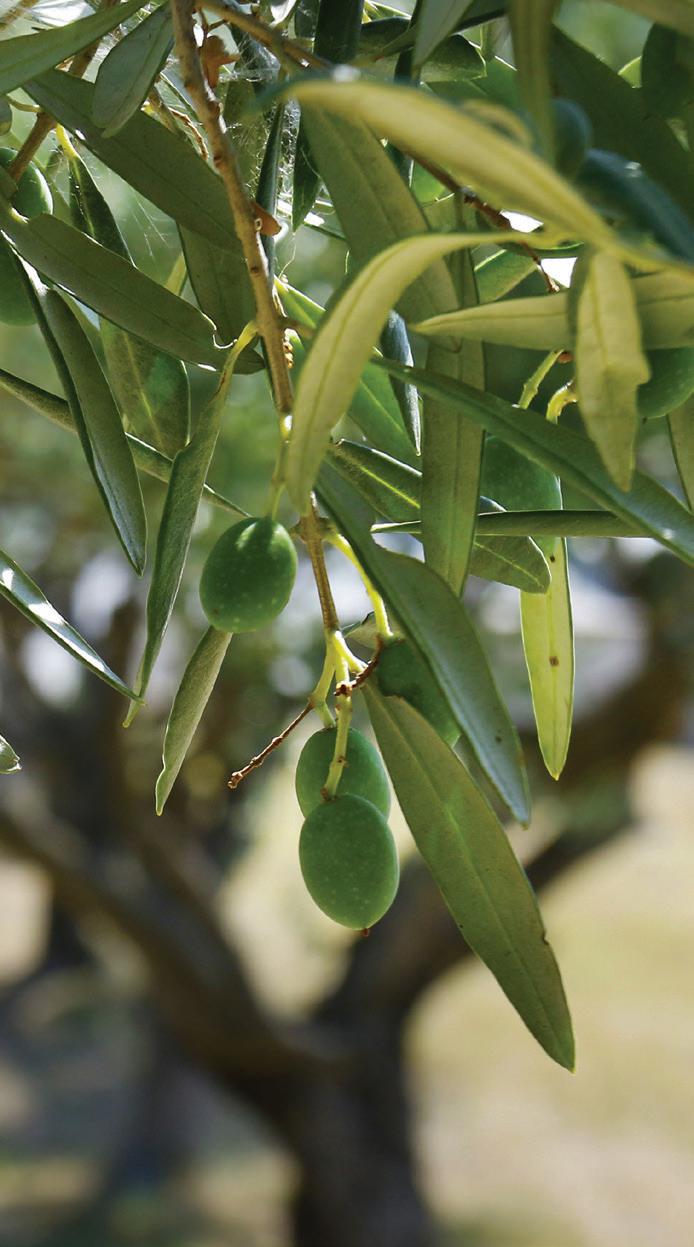
food products, such as canned goods, sauces, pastries and dairy products which are not only consumed domestically but exported to neighbouring countries and beyond.
The cheese manufacturing sector is growing both locally and regionally, the report says. Biscuits and chips are also increasing on average by 5-10% annually. The growth in the food industry is not only for local market needs but also caters to neighbouring counties such as Algeria, Libya and Morocco. Libya is a large Tunisian market due to zero import duties between the two countries.
Tunisia’s food market revenue amounted to US$8,089.00M in 2023 and is expected to grow annually by 6.8% (CAGR 2023-2027), according to the MPOC report. The market’s largest segment is confectionery and snacks, with a market volume of US$2,150.00M in 2023.
To support the growth of the food industry, the Tunisian government has implemented policies and initiatives to enhance the sector’s competitiveness and encourage investment. This includes providing incentives for agribusinesses, improving infrastructure and facilitating market access.
Since 2011, Tunisia has been heading for a macroeconomic crisis, facing large deficits, shrinking fiscal space and difficult
negotiations with the International Monetary Fund (IMF), according to a 23 January paper from the Malcolm H Kerr Carnegie Middle East Center.
“In this election year, policymakers face high stakes: A hard economic adjustment risks socio-political crisis, but without correction, the country faces a future economic meltdown.”
In 2013 and 2016 after the Arab Spring, the IMF issued two loans to Tunisia, comprising US$1.74bn and US$2.9bn respectively, but these did not have noteworthy effects on the economy, Foreign Policy Magazine wrote on 19 April.
“Today, after the COVID-19 pandemic and the start of the war in Ukraine, Tunisia faces significant food and fuel shortages, leaving the local population strained by hour-long queues at gas stations and empty shelves at supermarkets.”
Tunisian authorities and IMF leaders agreed on a bailout loan in October 2022, but President Kais Saied refused to sign the deal, saying that “foreign diktats” would lead to more poverty.
As part of the loan, the IMF requested that government subsidies on fuel and food should be eliminated, saying this would bring long-term benefits by rebalancing the budget and spurring economic activity, the magazine said.
However, past attempts by the Tunisian government to eliminate subsidies resulted in widespread protests, army crackdowns, and a state of emergency, with disastrous results on the economy.
“Removing subsidies on basic goods will also heighten inequalities and widen the gap between Tunisia’s coastal and interior regions, in turn hurting the country’s economic growth.”
The Carnegie Middle East Center says that the the presidential election scheduled for late 2024 is of great significance. They will be the first presidential elections since Kais Saied’s self-coup on 25 July 2021, when he dismissed the government of Hichem Mechichi and suspended the Assembly of the Representatives of the People.
“A rapid deterioration in economic and social conditions before June 2024 might increase the chances of victory for Saied’s opponents,” the centre writes. “Conversely, if the economy exhibits resilience, Saied’s re-election chances will rise.
Tunisia’s challenge is to find the narrow path to escape a crisis by generating confidence in a national programme that is politically acceptable and that can lead to a brighter future, the centre says. ● Serena Lim is the editor of Oils & Fats International (OFI)










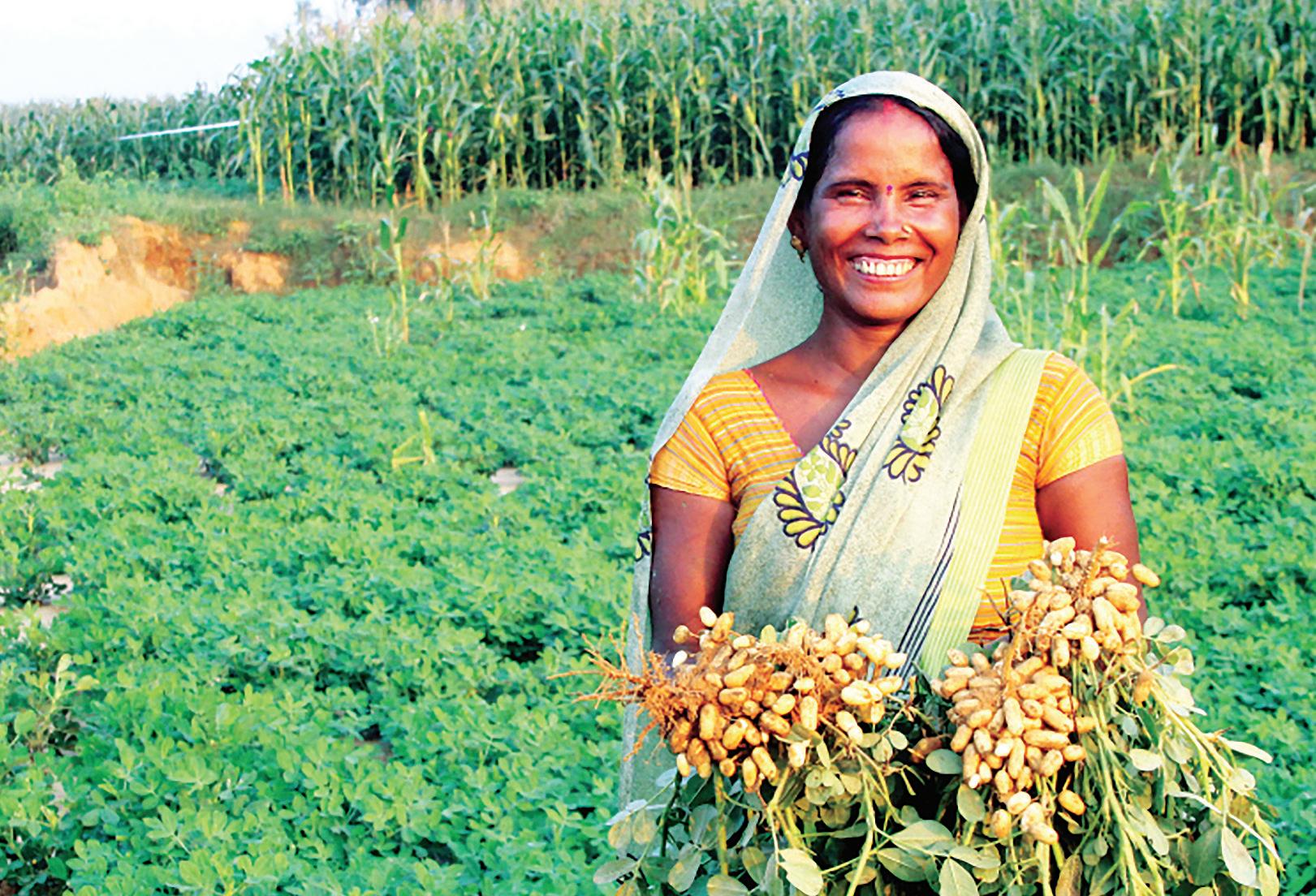
With global demand for peanuts forecast to reach 54M tonnes by 2026, new high oleic varieties containing elevated levels of monosaturated fats and proteins are being developed, including by leading producer India Gill Langham
Officially known as Arachis hypogaea and also known as groundnuts, peanuts are one of the most widely consumed oilseeds in the world, with the US Department of Agriculture (USDA) reporting that 49.8M tonnes were produced worldwide in 2022/23.
An accessible and reliable crop for farmers across diverse agro-climatic zones, the peanut’s adaptability enables it to thrive in varying environmental conditions, according to the International Crops Research Institute for the Semi-Arid Tropics (ICRISAT).
Cultivated extensively in tropical, subtropical and warm temperate regions,
peanuts are grown in more than 100 countries across six continents, ICRISAT says.
“Beyond its role as a staple food, groundnut holds paramount importance in the oil industry. The high oil content in groundnut kernels, combined with its favourable fatty acid profile, makes it a favoured source of edible oil worldwide,” ICRISAT says.
“Groundnut oil is not only known for its flavour but also for its heart-healthy monounsaturated and polyunsaturated fats, making it a desirable choice for health-conscious consumers.”
Peanut usage is not confined to the food industry and is also used in the cosmetic and personal care industry. For example, it can be used as a moisturiser and as a treatment for skin conditions such as eczema.
Covering an extensive area of approximately 32.7M ha globally, worldwide peanut production totalled 53.9M tonnes in 2021, according to the Food and Agriculture Organisation of the United Nations (FAOSTAT).
The leading peanut producers are China and India, highlighting the crop’s economic and nutritional significance in
these regions. Other significant producers are Argentina, Nigeria, Senegal, Sudan and the USA. Although accounting for less than 2% of global production, Brazil is the world’s fifth largest exporter of peanuts and the leading peanut oil exporter, according to the USDA.
In 2022/23, global production of peanut oil totalled 6.25M tonnes and is forecast to increase slightly to 6.32M tonnes in 2023/24, according to research by Statista.
USDA figures forecast global peanut oil production declining by 1.4% year-on-year in the 2023/24 season, with a projected output of 6.1M tonnes.
In 2024, the peanut oil market size is estimated at US$11.05bn and is expected to reach US$12.38bn by 2029, growing at a CAGR of 2.3% during the forecast period (2024-2029), according to a report by Mordor Intelligence.
The Peanut Oil Market Size & Share Analysis – Growth Trends & Forecasts (2024-2029) report says Asia-Pacific is the largest market for peanut oil, with China and India the largest consumers globally.
Peanut oil consumption in China alone totalled around 3.54M tonnes in the marketing year ending September 2023,












Learning from our 100+ customers, listening to their inputs and understanding their needs resulted in 600+ installed OLFB flaking mills worldwide.
Find out, how this flaking mill helps you to improve your oilseed production. Meet us at OFI International in Rotterdam at stand B21.



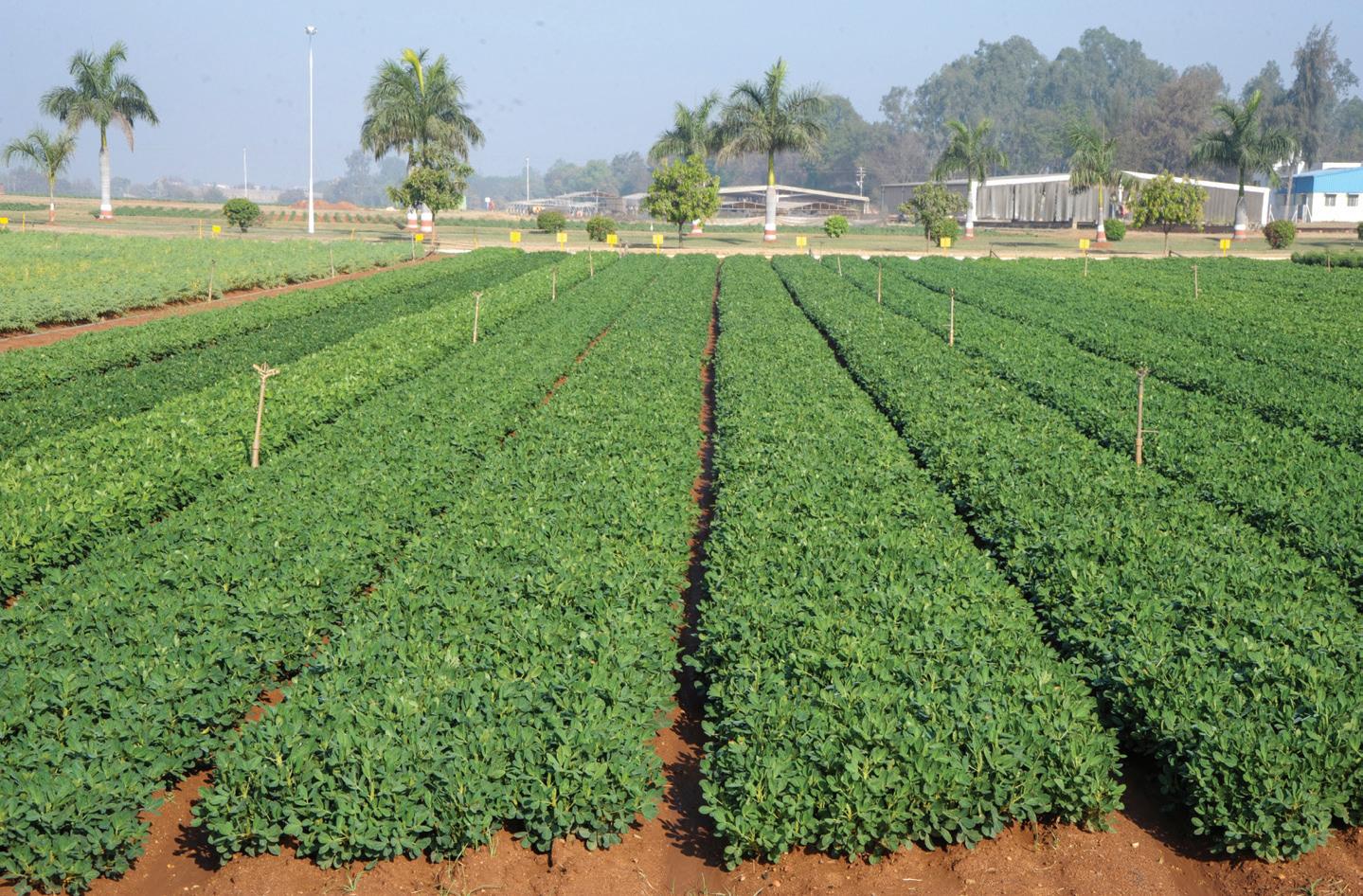
with the volume estimated to increase to 3.57M tonnes in the marketing year ending in September, Statista’s research department reported on 23 February.
High oleic peanuts have gained considerable attention in recent years within the sector due to their numerous benefits, including improved health profiles, prolonged shelf life and culinary versatility.
The global high oleic peanut oil market was valued at US$581.4M in 2022 and is forecast to reach US$806.4M by 2029, with a CAGR of 4.8% during the period, according to a report Global High Oleic Peanut Oil Market 2023 by Market Reports World.
High oleic peanut oil is rich in monounsaturated fats, particularly oleic acid, which is associated with various health benefits such as improved heart health, reduced inflammation and increased blood sugar control, global peanut exporting company Agrocrops says.
Consuming high oleic peanut oil as part of a balanced diet may help lower low-density lipoprotein (LDL) cholesterol levels, reducing the risk of heart disease. Additionally, its antioxidant content, including vitamin E, offers protection against oxidative stress and cellular damage, according to the company.
The United Nations Children’s Fund (UNICEF) mandates the use of high oleic peanuts for all producers of Plumpy’Nut, a therapeutic paste made from peanuts, due to its high oleic acid content, extended shelf life, and higher omega fatty acid content, ensuring higher quality and nutritional benefits.
High oleic peanut oil’s neutral flavour profile and high smoke point also makes it suitable for a wide range of cooking methods, including frying, sautéing, roasting and baking, Agrocrops says.
“One of the key advantages of high oleic peanut oil is its extended shelf life and superior stability compared to conventional peanut oil and other cooking oils. The high levels of monounsaturated fats in high oleic peanut oil make it less susceptible to oxidation and rancidity, resulting in a longer storage life without the need for added preservatives. These attributes make high oleic peanuts (HOPE) a popular raw material for snack food manufacturers, particularly for multinational brands.”
High oleic peanuts are grown worldwide, with different regions tailoring varieties to suit specific environmental conditions. Countries actively producing high oleic peanuts include the USA, Argentina, Australia, Brazil, China, India, Israel, Mexico, South Africa, Spain and others.
Examples of global developments in high oleic varieties include research by leading US agricultural institutions the University of Georgia and the University of Florida, which have developed the Georgia-06G and Florida-07 respectively. These varieties are recognised for their high oleic oil content and disease resistance, contributing significantly to the country’s peanut production.
China, as a major peanut producer, has begun cultivating high oleic peanut varieties like Huayu 22 and Zhonghua 6, developed by institutions such as the Peanut Research Institute of Shandong Academy of Agricultural Sciences. These
varieties have shown promising results in regions like Shandong and Henan.
Brazil’s high oleic peanut production is on the rise, with varieties like BRS 423, developed by the Brazilian Agricultural Research Corporation (EMBRAPA), gaining traction among farmers. Brazil’s production is expected to grow as high oleic peanuts become increasingly popular in the country.
In Europe, Spainish researchers are also exploring high oleic peanut cultivation, with varieties like Senia, developed by the Valencian Institute of Agricultural Research (IVIA), being prominent. Regions including Valencia and Andalusia are showing potential for high oleic peanut cultivation.
From its headquarters in Patancheru, ICRISAT has been working on groundnut genetic improvement since 1976.
Its works comprises acquiring germplasm, establishing breeding programmes and collaborating with National Agricultural Research Systems (NARS) in Africa and Asia.
Collaborating with NARS from 47 different countries in Africa and Asia, ICRISAT’s groundnut team works with the private food and seed industry to deliver demand-led groundnut crop products to stakeholders. The institute has successfully released approximately 225 groundnut varieties for cultivation in 38 different countries, all developed using ICRISAT supplied germplasm.
As part of the 12-year Tropical Legumes project, ICRISAT has developed 101 improved groundnut varieties tailored for 12 countries.
In India, working in collaboration with the Indian Council of Agricultural Research-Directorate of Groundnut Research (ICAR-DGR), ICRISAT has developed the country’s first high oleic acid (HOA) groundnut varieties, Girnar 4 (ICGV 15083) and Girnar 5 (ICGV 15090).
Compared to normal groundnut kernels, the high oleic lines have a kernel oleic acid content of almost 80% (of total fat content), while conventional kernels have only 40-50% oleic acid content. The new varieties are recommended for cultivation during the kharif (rainy) season in Andhra Pradesh, Gujarat, Karnataka, Rajasthan and Tamil Nadu states.
In partnership with Junagadh Agricultural University (JAU-Gujarat), ICRISAT later released two ‘Spanish-type’ HOA groundnut varieties, GG 40 (ICGV 16668) and GG 39 (ICGV 16697). These HOA lines are currently being tested for commercialisation in Bangladesh, India,
Malawi, Mali, Myanmar and South Africa.
The new groundnut line has recorded a 80.7% oleic acid and 3.6 % linoleic acid content. It has a protein content of 26% and an oil content of 51%. The new variety of groundnut matures in 113 days in the kharif season.
“The new groundnut line – being high yielding, drought tolerant and resistant to foliar diseases – will help increase the income of farmers and traders in India and enhance export opportunities for Indian groundnut,” ICRISAT’s Accelerated Crop Improvement Program cluster leader Dr Janila Pasupuleti says.
A significant commercial advantage of high oleic acid groundnuts is that the kernel develops a “nutty flavour” when roasted, making them in demand for confectionery products and peanut butter, Dr Pasupuleti says.
“The growing demand for groundnut oil in the pharmaceuticals and personal care sectors has further boosted its share in the global market, which is expected to account for US$3.28bn by 2029.
“We need to continually rethink which purposes our crops are focused towards, so that not only do we provide superior material for farmers, but also open up new markets for them – high oleic peanut is a good example,” ICRISAT’s Accelerated Crop Improvement Program global research director Dr Sean Mayes says.
Agrocrops is working to promote the use of high oleic peanut seeds in India and in other producing countries.
With over 55 years in the global peanut business, the company handles more than 150,000 tonnes/year of peanuts from over 20 origins, operates six peanut factories worldwide and supplies its peanuts and peanut ingredients to 50 global snack manufacturers.
In 2021, with the support of leading research institutions such as ICRISAT, Agrocrops acquired HOPE, a range of high oleic peanut seeds.
Agrocrops operates without directly owning farm fields; instead, it partners with Farmer Producer Organisations (FPOs), which are cooperative enterprises recognised by the Indian government. In partnership with FPOs, the company provides free seeds, essential farm inputs, training and other services through contract farming initiatives.
“We have been working with FPOs to cultivate both varieties, Girnar 4 and Girnar 5, but we primarily focus on the Girnar 4 variety,” Agrocrops senior manager quality assurance Ranjith Raju (pictured) says.

From an initial batch of 600kgs from ICRISAT, the first harvest yielded 14 tonnes of peanut shells and after two cycles, production increased to 300 tonnes in March 2024.
“Anticipating continued growth, we project this figure to reach 900 tonnes by December 2024. Our high oleic peanuts are available for commercial sale, marking a significant milestone as the first commercially available HOPE variety originating from India,” Raju says.
With their improved shelf-life qualities, HOPE varieties are primarily produced for the snack and confectionery sectors.
Although the production of high oleic peanuts involves specific cultivation practices and may also involve different input requirements to conventional peanuts, the high oleic varieties are often engineered for higher yields and improved disease resistance, Agrocrops’ Raju explains.
“This can translate to increased productivity per acre, potentially balancing out the higher seed costs,” he says.
In addition, high oleic peanuts often command premium prices in the market due to their health benefits and longer shelf life.
“This can potentially offset higher production costs and provide better returns for growers,” Raju adds.
High oleic peanuts also offer agricultural
advantages, such as improved disease resistance and higher yields, helping farmers to maximise productivity while contributing to soil health through nitrogen fixation, benefiting subsequent crops in rotation systems.
With food manufacturers, restaurants and bakeries increasingly seeking healthier oils and ingredients, the demand for high oleic peanuts is expected to increase.
For this reason, Raju believes high oleic peanut varieties are positioned to become the standard option within the peanut industry.
“While they may not entirely supplant traditional peanut varieties, they are poised to capture a significant market share,” he says.
Although Agrocrops remains focused primarily on the export market, the company has plans to expand its reach to the domestic multinationals which are presently importing high oleic peanuts into India for their production.
“The export potential of high oleic peanuts is promising, contingent on factors such as market demand, production capacity, adherence to international trade regulations, crop conditions and price competitiveness of high oleic origins such as Argentina,” Raju says.
“Internationally, high oleic peanuts present export opportunities, with countries like the USA and Argentina exporting to meet demand in global markets. Emerging markets show potential for increased cultivation and export as awareness of the health benefits of high oleic peanuts grows.”
Research and development efforts continue to improve high oleic peanut varieties, with advancements in breeding, processing technologies, and product development further enhancing their appeal and market potential.
Collaboration between agricultural researchers, peanut growers, food processors and marketers is key in promoting the adoption of high oleic peanut varieties and educating consumers about their benefits through marketing campaigns and educational materials. Raju says.
“As consumer awareness of high oleic peanuts and peanut oil continues to grow, there is potential for expanded market penetration and product innovation, including the development of new high oleic peanut oil-based products tailored to specific dietary preferences and culinary trends.”
● Gill Langham is the assistant editor of OFI

While bioplastics still only represent some 0.5% of plastics produced globally,
their production is growing, presenting an opportunity for the oils and fats sector
Andreia Nogueira
Oils and fats producers have an increasing business opportunity to supply feedstock to a booming bioplastics industry.
A plastic material is defined as a bioplastic if it is either bio-based, biodegradable, or features both properties, according to German industry association European Bioplastics.
‘Bio-based’ means that the material is (at least partly) derived from biomass (plants), such as the corn starch or sugarcane most commonly used to produce bioplastics today.
‘Biodegradable’ refers to the biochemical process in which microorganisms that are available in an environment convert materials into water, carbon dioxide and biomass, based on conditions such as temperature and humidity, and on the material or application itself. Being biodegradable does not depend on the feedstock material but is linked to its chemical structure.
“In other words, there are fully bio-
based plastics that are not biodegradable, and, some fossil-based plastics that can biodegrade under certain environmental conditions,” European Bioplastics said.
With some 350-400M tonnes of plastic produced each year globally, the spotlight has turned on bioplastics as a greener alternative to conventional plastics.
Germany’s Institute for Bioplastics and Biocomposites (Institut für Biokunststoffe und Bioverbundwerkstoffe – IfBB) told OFI that bioplastics meshed with creating a sustainable circular economy with extensive reuse and recycling. “In addition, more and more residual materials are being used for the production of bioplastics,” it said.
However, bioplastics represent only 0.5% of the 400.3M tonnes of plastic produced worldwide in 2022, according to Brussels-based industry association Plastics Europe. Of this output, China produced the most bio-based and bio-attributed plastics (33%), followed by the European Union (EU) and European Economic Area (EEA) countries (Iceland, Liechtenstein and Norway), said Plastics Europe.
After stagnating between 2018 and 2022, the bioplastics sector started growing last year thanks to “rising demand” and more “sophisticated applications and products”, according to European Bioplastics and German research organisation nova-Institute.
“Global bioplastics production capacity is set to increase significantly from around 2.18M tonnes in 2023 to approximately
7.43M tonnes in 2028”, with an average capacity utilisation of 82%, said a European Bioplastics report in December 2023. Significant market segments (see Figure 1, p39) worldwide in 2023 were:
• Polylactic acid (PLA), a biodegradable and recyclable polyester made from renewable feedstock, such as corn starch or sugarcane (31%);
• Polyamide (PA), also produced from renewable resources, such as castor oil (18.3%);
• Polytrimethylene terephthalate (PTT), a polyester synthesised for manufacturing carpet fibres (13.5%) and which can be made from corn and sugar;
• Polyethylene (PE), made from ethanol sourced, for instance, from sugar and wheat (12.3%).
There has also been a shift towards making biodegradable bioplastics such as PLA, rather than non-biodegradable lines, such as PA.
Both European Bioplastics and the nova-Institute said the share of global production capacity of biodegradable plastics against bio-based, nonbiodegradable bioplastics is expected to increase from 52.1% in 2023 to 62% in 2028. They also predict strong development in polyhydroxyalkanoates (PHA), which is a biodegradable plastic produced via bacterial fermentation from feedstocks such as corn, sugar, vegetable oils, agricultural waste products, industrial wastewater, food and fatty waste.
European Bioplastics added that “packaging remains the largest market segment for bioplastics, accounting for 43% (934,000 tonnes) of the total bioplastics market in 2023”. Other major applications are consumer goods, electronics, textiles and the automotive and transport sectors.
“Most companies using bioplastics are in markets that undergo the highest public scrutiny, such as food packaging, bottles, bags, straws and textiles”, Dr JanGeorg Rosenboom, co-founder and chief technology officer at US-based plastic manufacturer MacroCycle Technologies, told Oils & Fats International (OFI).
Market research firm Grand View Research predicts that the global bioplastics market will grow at a compound annual growth rate (CAGR) of 18.8% from 2023 to 2030 to reach US$44bn.
Pros and cons
When it comes to the question of whether bioplastics are better for the environment, the answer is not as obvious as some might believe, due to whether the product is recyclable, biodegradable, and compostable.
“Many bio-based plastics take as long as conventional plastics to decompose naturally,” according to a 2021 article by The Plastic People, a division of Barkston Plastics Ltd, UK.
Industrial composting is also necessary to heat bioplastics to a high enough temperature to allow microbes to break them down, according to a 2018 National Geographic article. “Without that intense heat, bioplastics will not degrade on their own in a meaningful time frame, either in landfills or a home compost heap.”
With too few composting facilities worldwide, many experts believe the solution to plastic waste mainly lies not in developing better bioplastics, but in overhauling the world’s economy to recycle far greater quantities of plastic because bioplastics also need careful collection and composting to regenerate natural materials, according to US-based Yale School of the Environment’s Yale Environment 360 magazine.
The Organisation for Economic Cooperation & Development (OECD) has raised doubts about the overall environmental benefits of bioplastics. In its Global Plastics Outlook: Policy Scenarios to 2060 released in 2022, the OECD said biobased plastics production was projected to rise but “at a slower rate than total plastics production”, with its share remaining marginal (at some 0.5% in 2060)”.
The OECD stressed that while bioplastics production was “less carbon-

intensive than fossil-based plastics”, it “relies on crops, which need extensive land ... potentially driving forest conversion and consequent emission increases”.
However, IfBB said the land use required [for bioplastics] was so small – equivalent to only 0.38% of the global agricultural area, according to its Biopolymers, Facts and Statistics 2023 report – that “this cannot be an argument”.
Another problem with bioplastics is that they “don’t compare to the strength and other properties of traditional plastic, and they cost substantially more”, Yale Environment 360 said.
Bioplastics are made with different production techniques.
Drop-in bioplastics, for example, utilise existing plastic manufacturing infrastructure to make materials that are chemically identical to their petrochemical-based counterparts, according to materials science online publication AZoM.
“Popular polymer materials PE, PET, propylene, PP, and nylon can all be replicated with biobased polymers (bio-PE, bio-PET, bio-propylene, bioPP, and biobased nylons). In addition, some bioplastics are manufactured with biobased production processes that are newly designed from the ground up, including materials manufactured using microbial reactions and nanotechnology synthesis processes like epitaxial growth.”
To overcome the higher cost of bioplastics, researchers at Pakistan’s Government College University Faisalabad advocated in a 2022 paper that “cheap or waste raw materials should be used”, including natural oils, waste cooking oil,
animal fats and plant oil mill effluents, along with microbial strains [genetic variants, subtypes or cultures].
Grand View Research agrees that cheap and plentiful feedstocks are available: “Potato, wheat, rice, vegetable oil, sugar, and corn are among the major raw materials of bioplastics,” it said.
Rosenboom said that most bioplastics companies were focusing on carbohydrate feedstocks such as corn or sugarcane, because microbial fermentation pathways creating bioplastics monomers or polymers were well-established, such as lactic acid for PLA and ethylene from corn/sugarcane fermented ethanol for bio-polyethylene. They could be tailored to their respective applications by compounding with additives, copolymerising or blending with other plastics, the IfBB said.
While some “pathways from vegetable oils and fats are much less explored”, there was R&D into using them to make bioplastics, Rosenbloom noted.
He told OFI that the “area of least resistance for vegetable oils to penetrate the bioplastic market” should be polyols to be used in mattresses and foams.
They “have been made from vegetable oils such as sunflower, soyabean, canola, palm and castor oils”, and companies active in this segment included US-based Emery Oleochemicals and Latvia-based Polylabs, said Rosenboom. In addition, epoxides (cyclic ethers) could be replaced with soyabean oil-based epoxides, he said.
Vegetable oils can also be “potentially useful for crosslinking”, making plastics change form from thermoplastics (deforming under heat and mouldable) to thermosets (where the shape is fixed independent of heat applied), which are u
commonly used in cars and wind turbine blades and which are “very durable and rigid materials”.
A market in expansion PLA and PHA are the most widely used bioplastic products. In 2022, researchers from MIT, including Rosenboom, identified large-volume producers of all bioplastics. This included Brazil’s Braskem, ‘I’m green’ bioplastics lines, with bioPE planned capacities of 260,000 tonnes/year by 2023; US-based firm Natureworks, with a PLA production capacity of 150,000 tonnes/year and planned annual capacity of 75,000 tonnes in Thailand by 2024 (some reports now say 2025); and the Netherlands’ TotalEnergies Corbion, with a 75,000 tonnes/year PLA production in Thailand. Other players identified included Italy’s Novamont, with a capacity of 150,000 tonnes/year making starch-based polymers (85% starch, the rest fossil-derived); and China’s BBCA Group, which had planned to increase its production capacity for PLA from 50,000 tonnes in 2020 to more than 100,000 tonnes/year by the end of 2023.
Other companies mentioned included Germany’s BASF, with capacity to make 74,000 tonnes of polybutylene adipate terephthalate (PBAT), a biodegradable and compostable fossil-based polymer; and Thailand’s PTT MCC Biochem, which can produce 20,000 tonnes/year of polybutylene succinate (PBS), made of 50% bio-based succinic acid and 50% petroleum-based butanediol.
Also identified were China’s Jinhui Zhaolong High Technology, producer of 20,000 tonnes/year of PBAT; USA-based Danimer Scientific, with an expected 2024 PHA production of 113,000 tonnes; and the USA and Singapore-based RWDC Industries, with planned PHA production of 25,000 tonnes/year.
Marco Jansen, Braskem’s EMEA biopolymers and Europe advocacy and sustainability director, told OFI that “investing in bioplastics production offers several advantages for a company already established in the plastics sector”, including “contribution to climate change mitigation and meeting sustainability goals”.
He said Braksem’s ‘I’m green’ bioPE had numerous rigid and flexible applications, including in the food and beverage, cleaning products and toy sectors. The company also offered other renewable product options such as ‘I’m green’ bio-based EVA, a bio-based ethylenevinyl acetate made from renewable sugar “commonly used in sports articles, footwear and toys”, and renewable-source polyethylene wax, used to make adhesives,

cosmetics, paints and compounds.
“Braskem’s bioplastics production process begins with the cultivation of sustainably-sourced sugarcane ... abundant in Brazil,” Jansen said. Sugarcane juice is extracted and fermented to produce ethanol, and then dehydrated to form ethylene, the monomer making polyethylene. Renewable ethylene is polymerised to form high-quality polyethylene used in the same applications as conventional resin.
To achieve carbon neutrality by 2050, Braskem plans to invest in other bioplastics: “We are exploring the production of renewables-based polypropylene” (PP) in the USA, Jansen said, adding that in 2022, the company partnered with Lummus Technology for the “global licensing of green ethylene technology for commercial-scale production, accelerating the development of chemicals and plastics produced from bioethanol”.
In 2023, Braskem advanced this technology and signed an agreement with Thai major SCG Chemicals, to “nearly double the production capacity of ‘I’m green’ bio-based bio-polyethylene” in a Thailand plant, said Jansen, stressing: “These two partnerships contribute to the goal of producing one million tonnes of ‘I’m green’ bio-based materials by 2030.”
Jansen said there was “significant room in the market to invest in bioplastics that use oils and fats as raw materials”, as such bioplastics meet the growing demand for sustainability “with greater flexibility and resilience in the supply chain”.
“Oils and fats, especially those of biological origin and collected from restaurants and the food industry, have
great potential (…) These oils can be refined and processed to remove impurities and be transformed into fatty acids and glycerol, which can then be converted into suitable monomers for biopolymer production. Fatty acids can be used, for example, in the production of bio-based polypropylene (PP), which has similar properties to conventional polypropylene derived from petroleum,” he told OFI.
Another active bioplastics company is Finland’s Neste. In 2020, it launched plastic raw material Neste RE – pure hydrocarbons made either from renewable (bio-based oils and fats) or recycled (liquefied plastic or rubber waste) sources, using the company’s NEXBTL next generation biomass to liquid technology.
Neste said its feedstocks included used cooking oil or residues from vegetable oil processing; technical corn oil, a residue from ethanol production from corn; tall oil-based materials, a residue from pulp mills; and fish and animal fat waste from the food industry.
Neste RE ends up in several products such as “cups, coffee caps, diapers, strollers, food packaging, medical products (such as catheters) and laboratory consumables”, the company said.
Buyers are watching. For instance, Coca-Coca introduced its PlantBottle made from 30% plant-based plastic in 2009, which now accounts “for nearly a third of its North American bottle volume and 7% globally”, according to Yale Environment 360.
Switzerland packaging firm Tetra Pak has also prospered from its Tetra Rex plant-based packaging. In 2021, it sold 17.6bn plant-based packages and 10.8bn plant-based caps, comprising 10% of its global products.
Meanwhile, Swiss food multinational Nestlé had committed up to US$2bn to develop food-grade recycled plastics and sustainable plastic technologies, including 100% bioPET, while carmaker Peugeot Citroën SA had pledged to make 20% of its plastics renewables-based, and Toyota had committed to buying 25% of the bioPE output from Braskem’s Brazilian plant, researchers at MIT, including Rosenboom, said.
The researchers stressed that investment and scaling of bioplastic technologies remained a high-risk business, with the central problem of uncertain demand owing to high prices and undefined EOL [end-of-life] treatment, although larger scale production “could reduce prices and create demand and incentives for recycling infrastructure”. Andreia Nogueira writes for International News Services, UK
A range of regulations govern deep frying to safeguard consumer health, covering the quality of fresh and used cooking oil, as well as additives, allergens, trans fatty acids, genetically modified oils and compounds such as acrylamide, 3-MCPDEs and glycidyl fatty acid esters
Bertrand Matthäus
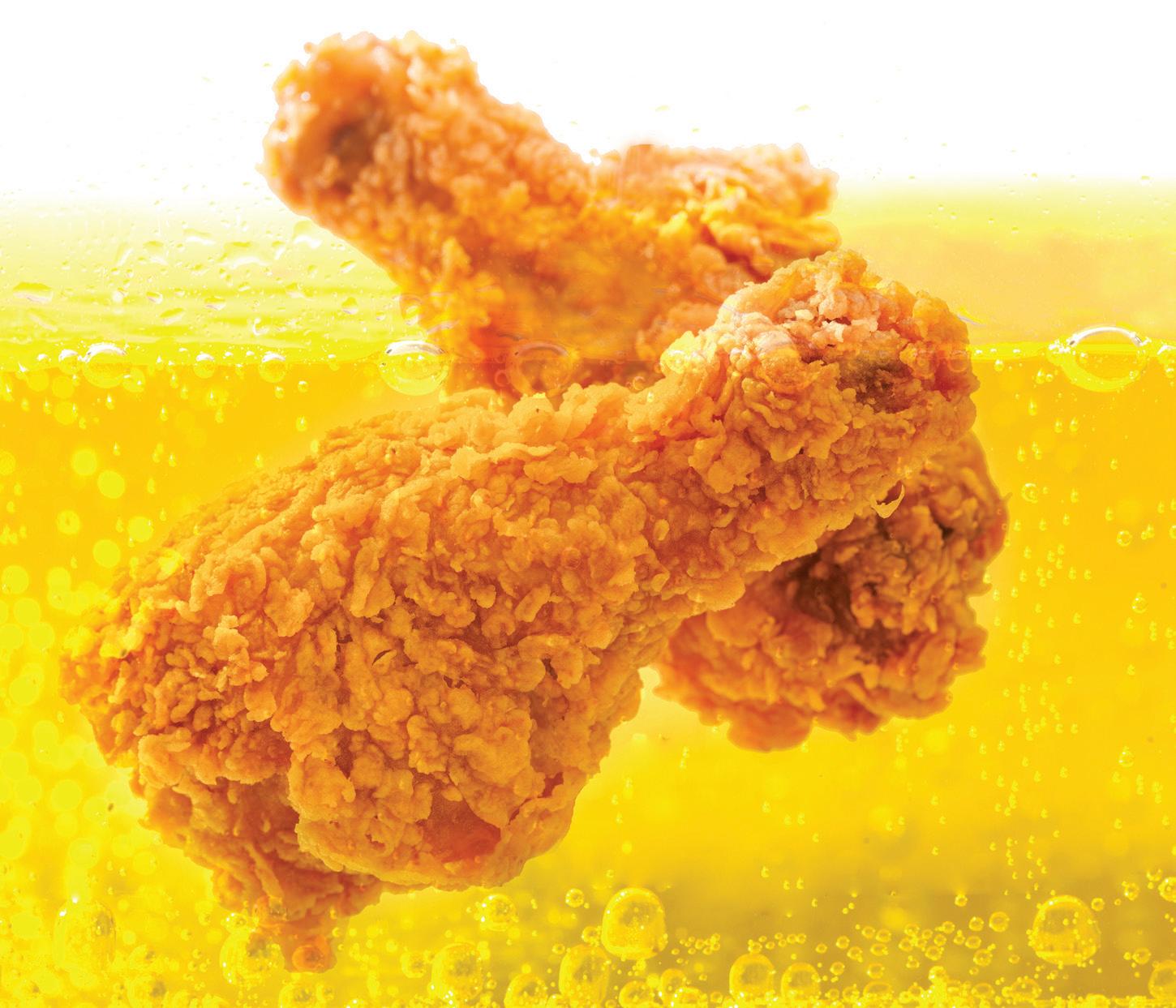
A range of regulations around the world govern deep frying to safeguard consumer safety. They cover compounds such as acrylamide, allergens, trans fatty acids (TFAs), free and bound 3-monochloropropanediol (3-MCPD) and glycidyl fatty acid esters (GEs), which are of health concern, as well as food additives and the quality of fresh and used frying oil.
Regulations are important to address product quality, as well as health and environmental issues.
Employees must be protected from volatile reactive degradation products in fumes, and there must be safeguards against smells and gaseous effluents in the environment.
Frying oils must be consistent in smell and taste and offer storage stability. There must be mitigation of heat-induced contaminants such as acrylamide, as well as other contaminants such as TFAs, 3-MCPDEs and GEs. Steps must also be taken to minimise degradation products in the oil and fried food, such as free fatty acids, polymer triacylglycerols, polar materials and oxidised fatty acids.
Increasing amounts of degradation products impair oil quality. While the nutritional effect from used cooking oils on mono-and diacylglycerols free fatty acids are harmless – along with di-and oligomer triacylglycerols and dimeric fatty acids because of their very low resorption rate – mono- and dimeric acids, oxidised cyclic fatty acids and other polar compounds have a negative nutritional effect.
Symptoms from the consumption of
highly oxidised oils include diarrhoea; myocardial inflammation; enlargement of the liver and kidney; anaemia; accumulation of peroxides in fatcontaining tissue; and the lack of vitamin E and selenium.
There is general agreement that harmful compounds are formed during frying but research shows that moderate consumption of used frying oils, based on good manufacturing practice (GMP), is not injurious. Nevertheless, quality control of the frying process is very important.
Codex Alimentarius sets out standards for food and residue limits, with code of practices, guidelines and recommendations.
Codex’s voluntary rules govern food hygiene; pesticide residues; labelling and presentation; methods of analysis and sampling; inspection and certification; food additives; and contaminants.
There is a Codex Standard for Named Vegetable Oils (CODEX STAN 2101999) which sets out quality standards for edible oils including data on fatty acids, tocopherols and phytosterols; and quality criteria on chemical and physical parameters such as density, refractive index and peroxide value.
In the EU, Regulation EC No 178/2002 lays down the general principles and requirements of food law. Complete traceability of products in the production chain is mandatory, and operators must apply the legislation at all stages of the food chain, from production, processing,
transport and distribution through to the supply of food.
No food can be placed on the market if it is unsafe, with food deemed unsafe if it is considered to be injurious to health and unfit for human consumption.
Frying oils are regarded as food in the EU as they are taken up by a food item during frying. A long-term used frying medium should not be suitable for human consumption but there are no legal regulations for heated oils and fats at the EU level.
Very few countries have adopted legislation on used frying oils but if regulations or standards are available, they are often based on the recommendations of the Germany Society for Fat Research (DGF) from 1973, which deem that used frying fats and oils are deteriorated if:
• On sensory assessment, the taste or flavour is unacceptable
• Polymer triacylglycerols levels are >2%
• Polar compounds are >24%
• The acid value is >=2.0g/100g
• Petroleum ether insoluble oxidised fatty acids are above 0.75%
• The smoke point is >=170°C
• The smoke point difference is >50°C
• Oxidised fatty acids are above 1%
Frying oils or fat extracted from fried food that exceed these limits are not suitable for human consumption. The 3rd International Symposium on Deep-Fat Frying in 2000 also recommended that:
• The principal quality index for deep fat frying should be the sensory quality of
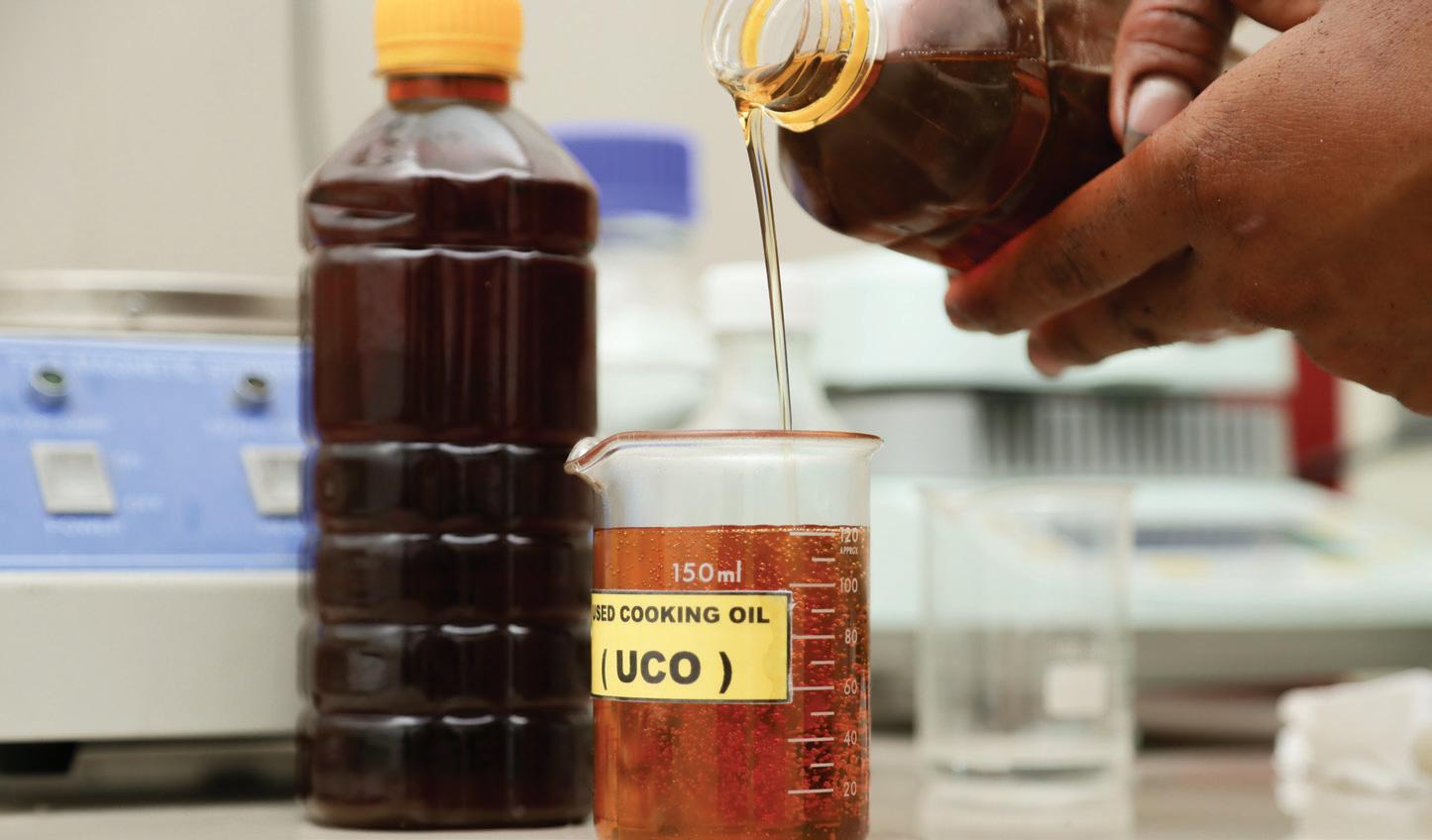
the food being fried.
• Analysis of total polar compounds and polymeric materials (polymerised triacylglycerols) should be utilised to confirm suspect/abused frying fats and oils.
• The use of rapid tests for monitoring oil quality is recommended.
• Filtration is one of the basic tools to ensure food and oil quality.
• Used, but not abused, frying oils may be topped up or diluted with fresh oil with no adverse effects on quality.
Additives such as antioxidants and anti-foams can be added to frying oils to control foaming during frying and to extend the lifespan of the oil.
Additives are defined as ingredients of food not normally consumed as food themselves. All additives in the EU must be authorised and listed with conditions of use in the EU’s positive list based on a safety assessment and technological need, with an assurance that the use of the additives will not mislead consumers. These rules are set out in Annex II of EU Regulation (EC) No 1333/2008.
In the USA, regulations for food additives and colour additives are listed in 21 Code of Federal Regulations (CFR),
Parts 172 and 173, and Parts 73, 74, respectively. ‘Generally Recognized as Safe’ (GRAS) substances such as alphatocopherol, beta-carotene and citric acid –which are added to frying oils to improve their oxidative stability – are listed in 21 CFR Parts 182 and 184.
Hazard Analysis and Critical Control Point (HACCP) is a concept to identify, access and control danger regarding food safety:
• Analysing possible danger (biological, chemical and physical).
• Identifying points where danger could occur.
• Deciding which points are critical (a point is only ‘critical’ if danger can be avoided by appropriate action).
• Defining safety measures.
• Verifying the introduced concept.
The HAACP concept in relation to frying out is set out in Table 1 (below).
Industrial trans fatty acids (iTFAs) – as opposed to naturally-occurring TFAs from the meat and milk fat of ruminant animals – are formed during partial hydrogenation of oils to turn them into semi-solid or solid fats, which have increased resistance to
Relevant danger Formation of substances in toxicological relevant amounts
CCP Yes
Limit Oligomer triglycerols >12%; total polar amounts >24%
Control Quick test
Measure Removal and exchange of frying oil
Documentation Documentation of the values with date and time
Responsibility Chef de cuisine
Source: 11th Deep Frying Symposium, 27-29 March 2023, Hamburg, Germany
oxidation and a long shelf-life.
Various clinical studies have shown that TFAs raise low density lipoprotein (‘bad’) cholesterol in blood, and lower high density lipoprotein (‘good’) cholesterol, increasing the risk of heart disease.
According to a World Health Organization (WHO) news release in January 2023, trans fat intake “is responsible for up to 500,000 premature deaths from coronary heart disease each year around the world”.
The WHO recommends that no more than 1% of our daily energy intake in kilojoules should come from TFAs.
In the EU, an amendment to Annex III of Regulaton (EC) No 1925/2006 states that the content of trans fat – other than naturally-occurring trans fat of animal origin – in food intended for the final consumer and food intended for supply to retail, should not exceed 2g/100g of fat.
In addition, food business operators supplying other food business operators with food not intended for the final consumer or not intended for supply to retail shall ensure that food business operators are provided with information on the amount of trans fat, (other than trans fat naturally occurring in animal origin fat), where that amount exceeds 2g/100g of fat.
The formation of TFAs during the frying process is negligible, if frying conditions are in line with GMPs and recommended temperatures are not exceeded.
TFAs are regulated in different ways around the world, with some countries mandating TFA labelling.
Acrylamide is a chemical that naturally forms in carbohydrate-rich food products during high-temperature cooking and is mainly formed from reducing sugars like glucose or fructose, and amino acids, particularly asparagine.
The European Scientific Committee on Food evaluated acrylamide in 1991 as a “genotoxic carcinogen” while the International Agency for Research on Cancer stated in 1994 that acrylamide is “probably carcinogenic to humans”.
According to the European Commission’s Joint Research Centre, acrylamide is a “non-threshold carcinogen”, and it is recommended that human exposure to the chemical be restricted as much as possible, applying the As Low As Reasonable Achievable (ALARA) principle.
However, epidemiological studies have not shown any correlation between acrylamide in food and the occurrence of different types of cancer.
The most important measure to minimise acrylamide formation is temperature control.
In EU regulation 2017/2058, there is a benchmark maximum level of 500μg/kg established for ready-to-eat French fries, while the maximum benchmark level for potato crisps and crackers is 750μg/kg. If benchmark values are exceeded, food business operators must apply mitigation measures. In addition, EU regulation defines a maximum temperature of:
• 160-1750C when frying french fries and other cut deep-fried or oven-fried potato products; and 180-2200C when using an oven.
• 1680C at the exit of the fryer for sliced potato crisps.
EU Regulation 202/1322 sets out maximum levels of 3-MCPD, 3-MCPD fatty acid esters and GEs in certain foods.
For GE, expressed as glycidol, the level is 1ppm. For 3-MCPD and 3-MCPD esters, the level is 1.25ppm for coconut, maize, rapeseed, sunflower, soyabean, palm kernel and olive oils.
For other vegetable oils – including olive pomace, fish and marine organism oils – and mixtures of oils and fats in this category, the level is 2.5ppm.
For mixtures of oils and fats from the two categories, the level is 2.5ppm.
Both the EU and USA have allergen regulations.
EU Regulation No 1169/2011, Article 9(c), Annex II defines allergens as “substances causing allergies or intolerances”, which includes milk and milk products; egg; fish; crustaceans; nuts (almonds, hazelnuts, walnuts, cashew); cereals containing gluten; peanuts and their products; and soyabeans except fully refined soyabean oil; and celery, mustard, sesame, sulphites, lupin and molluscs.
The US Food Allergen Labelling and Consumer Protection Act (FALCPA) defines major food allergens as products which protein derived from milk, egg, fish crustacean shellfish, tree nuts, wheat, peanuts and soyabeans.
Allergenic substances have to be labelled, if they are ingredients of a foodstuff. For example, in the case of doughnuts fried in (hydrogenated) peanut oil, the use of peanut oil must be labelled.
A typical example of an allergenic contaminant are traces of seafood protein in frying oil, which is used alternately for shrimps and french fries.
The labelling of allergenic contaminants is not obligatory in most countries.
However, this may change with proposals for a Voluntary Incidental Trace Allergen Labelling (VITAL) system in Australia, New Zealand and Switzerland.
An increasing proportion of edible oils – such as soyabean, corn, rapeseed and cottonseed oils – are produced from genetically modified (GM) plants.
The use of GM organisms (GMOs) for food and feed must be approved by national or international food authorities.
The labelling of GM food is required in Europe, Australia, Brazil, China, India, Japan, New Zealand, South Korea and the USA.
Fully refined oils and food served in restaurants and fast-food outlets have to be labelled as “genetically modified” or “bio-engineered” in most countries.
In the EU, all food (including processed food) or feed which contains more than 0.9% of approved GMOs must be labelled, even food served in restaurants and fully refined frying oil.
Waste cooking oil can be defined as used cooking oil (UCO) originating from food manufacturers, restaurants, and industrial kitchens; and oil that has been dumped in sewers.
The EU defines all waste food, including UCO, as originating from restaurants, catering facilities and kitchens, including central kitchens and household kitchens. Heath risks related to UCO include:
• Undesirable levels of contaminants such as polycyclic aromatic hydrocarbons (PAH), polychlorinated biphenyls (PCBs) and dioxins.
• Some toxicity (such as triacylglycerol dimers, trimers and other polymers, cyclic monomers and compounds derived from the oxidation of cholesterol) as a result of oil degradation during frying and cooking.
• Risks for animal health due to the use of UCO in animal feed and, as a result of bio-accumulation, for consumer health as well.
The heat treatment of UCO during processing leads to oxidation and degradation products, and oil soluble components from processed products. Sewer oil can contain mixtures of vegetable and animal oils, together with oil soluble and solid components obtained from fat separators, and its treatment can result in oxidation and degradable products, oil soluble components, and an undefined mixture of other compounds. In the EU, there is no direct legal
regulation regarding the use of waste cooking oils in nutrition.
However, regulation EC No 1774/20023 lays down health rules concerning animal by-products not intended for human consumption, and catering waste is not allowed in animal nutrition as the traceability of these products cannot be guaranteed.
No foodstuff dangerous to health and/ or unfit for consumption may be placed on the market, but oils from manufacturing premises are felt to be identifiable, traceable and to contain no specified deleterious or prohibited contaminants.
EU regulation allows the use of waste oils from the food industry (other than catering facilities) where a credible system of traceability and quality control can be ensured.
The recycling of UCO into technical products for pure industrial uses – such as production of soaps, biodegradable lubricants or biofuels – is allowed.
Frying is a complex process that leads to the deterioration of the frying medium with progressive frying time, depending on the frying conditions.
During frying, part of the frying medium is absorbed by the fried food, so that the frying medium becomes part of the fried food. Therefore, a number of regulations and recommendations are available to ensure that the quality of the fried food is not negatively affected by the frying medium and that the safety of the food remains assured.
There is no specific regulation for used frying oil but EU regulation 178/202, other regulations in the world, along with different recommendations that describe quality parameters for used frying oils, provide the framework for assessment.
In addition, for contaminants such as acrylamide, 3-MCPDEs, glycidyl esters and trans fatty acids, different regulations ensure that a risk to consumers can be ruled out.
All these regulations and recommendations cannot prevent the formation of undesirable substances and a decrease in oil quality during frying, but they do ensure that the frying process and the food produced from it are safe for the consumer if the specifications are fulfilled.
Even if the specifications of used frying oils differ to some extent from country to country, the general aim of ensuring the safety and quality of fried food is always the same in each country. ● Bertrand Matthäus is the head of the Department for Safety and Quality of Cereals at the Max Rubner-Institut, Germany
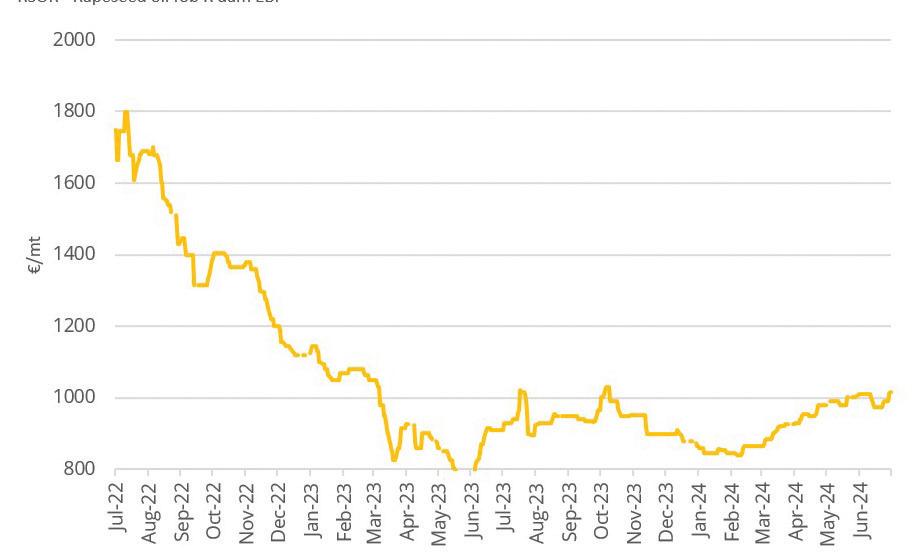

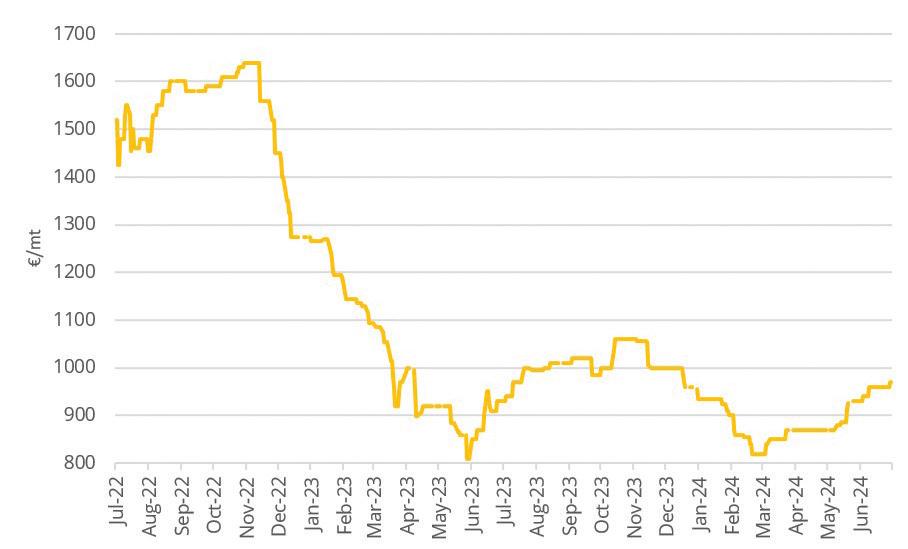
The Expana Benchmark Price (EBP) for rapeseed oil FOB Rotterdam was assessed at €1,015 on 3 July; a 3% increase on the week and up by 0.5% month-on-month (m-o-m). Concerns over the rapeseed crop across major producers including Australia, the EU and Ukraine have propelled bullish sentiment in the market. Market sources have noted that the comparatively higher prices of rapeseed oil could shift demand to alternative oils (palm and soyabean oils), limiting further price increases.
Further compounding the bullish sentiment are expectations of a tighter balance sheet for the upcoming 2024/25 season. The US Department of Agriculture (USDA) estimated global rapeseed production down marginally by 0.1% for the 2023/24 season with expectations of a further decline to 87M tonnes (–1.9% year-on-year/ y-o-y) for the 2024/25 season. Weather conditions with forecasts pointing towards frosts and excessive moisture across key growing regions will remain a major watch point for crop supply and prices. The US Environmental Protection Agency’s recent approval of rapeseed oil as a biodiesel feedstock will also be a factor for demand direction.
The Expana Benchmark Price (EBP) for soyabean oil FCA Netherlands was assessed at €907/tonne on 3 July, up 1% week-on-week and 4.3% m-o-m. The price increase is attributable to a slight recovery in EU demand amid concerns about rapeseed and sunflower oils supply.
Globally, the soyabean market sentiment remains neutral-bearish despite downward revisions to the Brazilian crop due to heavy flooding in May. This is due to ample supply from South America on the back of a huge crop in Brazil and a 100% y-o-y recovery to the Argentinian crop for the 2023/24 season. For the upcoming 2024/25 season, expectations are for a y-o-y increase in output for both countries. In the USA, weather conditions will be a major watch point in the coming months as the soyabean crop enters its key developmental stages come August.
Higher biodiesel mandates in Brazil and government policies amid economic challenges in Argentina will be a factor for farmer selling and exports of soyabean and soyabean oil. Demand from China will also be critical as its import demand is likely to rise in July due to concerns and uncertainties over its trade war with the USA.
In its June update, the USDA estimated global soyabean production reaching 396M tonnes in the 2023/24 season; 4.6% higher than the previous season, while a 6.7% y-o-y increase is forecast for the 2024/25 season. Global soyabean oil production is estimated 4.8% higher y-o-y for the 2023/24 season with similar growth forecast for 2024/25.

Expana provides independent insight and data to help companies make informed commercial decisions.
Tel: +44 (0)1628 851313
E-mail: sales@Expanamarkets.com Website: www.Expanamarkets.com








































